
Regions [ edit ]

Cities [ edit ]
- 44.02734 145.86146 3 Yuzhno-Kurilsk – Largest town in the Kuril Islands
Other destinations [ edit ]
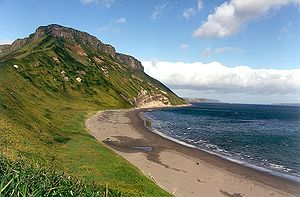
Understand [ edit ]
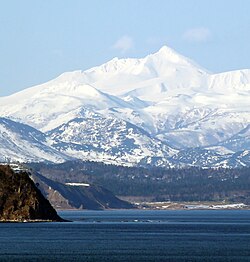
The original inhabitants of the Kuril Islands were the Ainu people, who also live on the Japanese island of Hokkaido, and the Russian island of Sakhalin. With the establishment of diplomatic relations between the Russian Empire and Japan in 1855, the islands were divided between the two countries, then another treaty in 1875 nominally placed the islands under Japanese control. At the end of World War II , the Soviet Union took control of the islands. They were then ethnically cleansed of their Japanese populations in 1947, and thoroughly Russified.
Though still claimed by their former owner, Japan, the Kurils are now thoroughly Russian. Similar to other parts of the Russian Far East, this remote, sparsely populated area has see little industrial development. Most locals make their living fishing in the island chain's abundant waters. The chain's most populated island is Kunashir, centered on Yuzhno-Kurilsk , but its smaller administrative capital Kurilsk is located on the biggest island, Iturup.
Talk [ edit ]
As with the rest of Russia, Russian is the predominant language. Ainu was the historical language of the islands, but the local Ainu have been thoroughly assimmilated into the ethnic Russian majority, and the Ainu language is now extinct in the Kuril Islands.
Get in [ edit ]
Traveling to the Kuril Islands is notoriously difficult . Always plan your trip in advance and make sure that you have at least few extra days on your visa, because weather situation and traffic tend to be unpredictable. Be aware that some essential steps in getting permits and booking tickets can be done on Sakhalin only . Therefore, you will need good friends there, or rather ask travel support from a tour company. Although many travelers try to avoid hassle and go for all-included tours, some of the travel arrangements can be done on your own, which of course cuts the price substantially.
Most travelers visit South Kurils that have fairly bad but at least regular connections to Sakhalin . Northern islands can be reached by occasional boats and helicopters from Kamchatka . The middle part of the ridge is uninhabited and basically unreachable, unless you own a boat, wings, or at least enjoy strong support from the Russian military who are the only people visiting this remote area.
Read the Sakhalin article to learn about flights and ferries to that island (there are multiple connections, so this part is pretty easy). Remember that all transport to (and between) the Kurils is strongly subjected to weather conditions, hence a seamless travel to the islands does not mean that you will easily get back. Always schedule enough time before the next leg of your journey.
Get around [ edit ]
See [ edit ].

Do [ edit ]
Eat [ edit ].
Be sure to eat seafood in the Kurils, as the fishing in this part of the North Pacific is considered some of the best in the world. You may well see this seafood available in expensive restaurants around the world offered at prices a hundred times what it will cost to enjoy it here.
Drink [ edit ]
Stay safe [ edit ].
This is not a very big problem as not much crime happens around there.
Go next [ edit ]
- Hokkaido — Japan's northernmost island paradise for skiing, hot springs, and delicious regional cuisine is a relatively short ferry ride away from Sakhalin , although there are no regular ferries between the Kurils and Hokkaido due to the political conflict.
- Kamchatka — If you have the time to wait and find someone to ferry you from Severno-Kurilsk it's a beautiful destination for outdoors enthusiasts and a worthwhile addition to a Kurils trip.
- Sakhalin — Russia's largest eastern island is the most convenient point of entry to the Kurils, and the most convenient point of exit.
- Has custom banner
- Has mapframe
- Maps with static images
- Has map markers
- Outline regions
- Outline articles
- Region articles
- Has Geo parameter
- Russian Far East
- All destination articles
- Pages with maps
Navigation menu
Plan Your Trip to Kuril Islands: Best of Kuril Islands Tourism
Essential kuril islands.
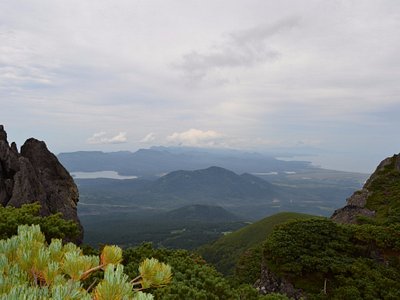
- Tyatya Volcano
- Volcano Baransky
- Cape Edge of the World
- Vannochki Hot Springs
- Mendeleyev Volcano
Russia's Ring of Fire: Kamchatka and Kuril Islands
- Get inspired by the possibilities.
- Build your ideal trip.
- Explore the Kamchatka Peninsula, Commander Islands, and Kuril Islands
- See one of the world's richest wildlife areas in species and abundance
- Discover the cultural and Soviet history of the Ring of Fire
- Experience unique volcanic landscapes and geothermal activity
- Small Ship Cruises
- Wildlife Viewing
- Adventure Options
- Russian Far East
- Atlasova Island
- Bukhta Russkaya
- Commander Islands
- Kunashir Island
- Kuril Islands
- Petropavlovsk-Kamchatskiy
- Zhupanova River
Full Itinerary
Day 1: otaru, japan| embark, day 2: sakhalin island, russia.
- 1 Breakfast, 1 Lunch, 1 Dinner
Day 3: Kunashir Island
Day 4: iturup island, day 5: simushir island | yankicha island, day 6: ekarma and onekotan islands, day 7: atlasova island, second kuril strait ptich’i rocks, day 8: bukhta russkaya, kamchatka, day 9: zhupanova river, kamchatka, day 10: olga bay, day 11-12: commander islands.
- 2 Breakfasts, 2 Lunches, 2 Dinners
Day 13: At Sea
Day 14: petropavlovsk- kamchatskiy | disembark.
- 1 Breakfast
Heritage Adventurer
Dates & prices, my preferred start date.
Initial deposit is 25%, and most travelers will call our office and pay the deposit with a credit card.
Final payment is due 130 days prior to departure by Bank transfer, check or credit card. All final payments by credit card may be subject to a surcharge and maximum of $20,000 charge
See our general terms and conditions:
- Adventure Life Terms & Conditions
We are an agent for one or more providers on this trip with specific cancellation policies and terms:
- Heritage Expeditions: Terms & Conditions - Heritage Expeditions
For full cancellation policy details, please contact us for a quote.
- 13 Breakfasts, 12 Lunches, 13 Dinners
- 13 Nights Accommodations
- Accommodations as listed
- Ground transportation as listed
- Activities as listed
- Meals as listed
- Access to a 24-7 Emergency line while traveling
- House beer, wine and soft drinks with lunch and dinner
- One night hotel accommodation in a twin share room (incl. dinner/breakfast)
- All expedition shore excursions
- Programme of lectures by noted naturalists
- Travel Insurance
- Personal Expenses
- Flight costs (please request a quote)
- Additional excursions during free time
- Fuel and transportation surcharges (when applicable)
- Required Visas if applicable
- Laundry
- Mandatory medical evacuation insurance
We Love to Talk Travel
Why travel with adventure life, recognized by.


Share ×

Scan the QR code and open PeakVisor on your phone
❤ Wishlist ×
See all region register, peakvisor app, kuril islands.
Explore Kuril Islands with the PeakVisor 3D Map and identify its summits .
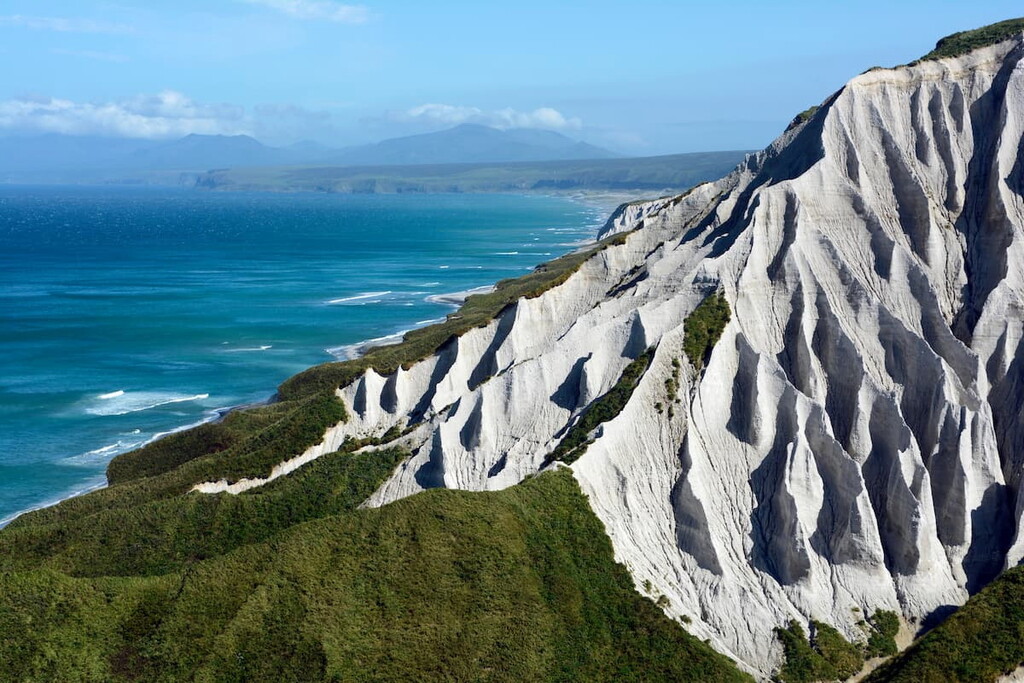
Destination guides
Download free Russia travel guides
- St Petersburg
- Golden Ring
- Lake Baikal
- Murmansk (Kola Peninsula)
- Moscow & St Petersburg
- Russia River Cruises
- Expedition Cruises
- Trans-Siberian Tours
- Northern Lights Tours
- Siberia Tours
- Winter Tours
- Students Trips
- Luxury Tours
- Plan My Tour
Start planning my tour
Your Russia, your dates, your mates
- Destination Guides
- Russia Travel Tips
- Russian Visa
- Travel Insurance
- Why 56th Parallel
- Traveller Reviews
Ring of Fire – Kamchatka, Commander & Kuril Islands Expedition Cruise
Duration 14 days
Price from USD $9,450 ? Currency Conversion Converted from USD based on the latest exchange rate. Final amount and payment will be in USD. Final conversion rate is determined by your bank.
Trip Style Expedition Cruise
Time of year May - June
Home / Kamchatka Tours / Ring of Fire – Kamchatka, Commander & Kuril Islands Expedition Cruise
- Dates & Prices
A once-in-a-lifetime Russia cruise in the spirit of the great explorers, embark on a Russia Far East Cruise of unparalleled adventure into the Pacific Ring of Fire. Here, Mother Nature still reigns supreme. Mighty volcanoes (mostly only half-asleep), cast their magnificent shadows across bizarre and beautiful landscapes.
Nowhere else on earth can the eruptive forces of nature be experienced more intensely than where the Pacific Ring of Fire meets the Russian Far East. Stretching for 50,000km around the Rim of the Pacific Ocean, most of the earth’s volcanoes are located around the edge of the Pacific Ring of Fire. Along with one of the world’s most active plate boundaries, millions of years of volcanic and geothermal activity have brought islands up from the sea and carved the land into the most unique and amazing shapes and formations.
Departing from Otaru in Japan, the Russian Far East Cruise will forge towards the absolute northern reaches of the Pacific, where few cruise ships have ventured before. Next, it's on to the volcanic archipelago of the Kuril Islands, whose forests and grasslands are home to brown bears and Arctic foxes and even a small community of hardy fisherfolk. Upwellings from the deep volcanic trenches surrounding the islands and the Kamchatkan coastline create perfect conditions for ocean-going wildlife. Not only will you witness incredible sightings of seabirds in astounding numbers in astounding numbers, but this cruise also provides exciting opportunities day after day to spot several species of whales and dolphins as well as otters, seals and sea lions. After the Kamchatka cruise, we head for the tundra-covered lands of the Commander Islands, home to massive colonies of seabirds.
Ring of Fire: Russian Far East Cruise Highlights:
- Commander Islands Cruise: spend two days discovering the Commander Islands, following the footsteps of legendary Danish Commander Vitus Bering. The surrounding waters are home to at least 20 species of whales. Fin whales, sei whales and humpbacks are commonly spotted, and extremely rare sightings of Pacific Northern right whale have also been recorded. Along the shore, spot sea otters, northern fur seals and Stellar’s sea lions.
- Despite their desolate appearance, one of the Commander Islands, Bering, is home to a single permanent settlement. Around 800 people, a mix of Russians and indigenous Aleuts inhabit Nikolskoye. We’ll drop in on this rarely-visited village, where the locals have established a museum on their national culture and natural history.
- Kuril Islands cruise: There’s nothing quite like a visit to Sumushir Island in the middle of the Kuril Islands chain. The island wasn’t always uninhabited. From 1987 to 1994 the Soviets operated a top-secret submarine base in the island’s north - former population, 3,000. Now, the settlement lies completely abandoned. Russian military equipment rusts on the beach and there are few signs of life inside the eerily empty buildings.
- They say Yanchika is the most visually stunning island in the Kurils. Dominated by a sinking caldera (volcanic crater), once you set foot on the island and make your way up the grass-covered exterior slopes, the view from the top reveals Yanchika’s extraordinary hidden beauty. The massive caldera is flooded with seawater, forming a vast, mesmerisingly calm blue lagoon. Yet Yanchinka is still very much active, with hot springs and fumaroles spewing steam near the edge of the barren caldera walls.
- The wildlife watching opportunities on this cruise are world-class. Birders can attempt to cross off over 14 species, often in mindblowing density as we approach their nesting sites on rocky shorelines and in the nooks and ledges of sea cliffs. Set eyes on vast numbers of tufted and horned puffins, whiskered and rhinoceros auklets, spectacled and pigeon guillemots, Laysan albatross, mottled petrel and many others. Multiple species of cetaceans are guaranteed. Expect to spot fin, sei, sperm, humpback and minke whales as well as orca, Dall’s porpoise and on rare occasions, Baird’s beaked whale.
Although this wild and seemingly inhospitable region is best known for its incredible abundance of wildlife, the human history of the islands is a fascinating story in itself.
The Ainu people were the original settlers of the Kuril Islands. The 18th century saw the great Danish explorer, Vitus Bering, sailing for the Russian Navy, charting out the Commander and Kuril Islands in search of new territory. His arrival would eventually lead to the displacement of the Ainu by the Cossacks, and the beginning of a tense territorial dispute over the Kurils that is hotly debated to this day. At the height of the Cold War, the Soviet Empire laid claim to the entire region, basing its formidable Pacific Fleet in these waters.
The secrecy surrounding the fleet and its military bases was so closely guarded that the region was closed even to ordinary Russians. Only in the last few decades have outsiders been able to travel here relatively freely.
Undisturbed by political disputes raging over the Kurils, a population of Russian and Aleut (indigenous Alaskans, brought to the Commanders by Russian fur traders in the early 1800s) continued to eke out a simple existence, fishing and hunting on Bering, the largest of the two main Commander islands. A handful of their descendants still live there today. The islands were named after Commander Vitus Bering, who died on the island of his namesake when his shipwrecked in 1741.
Today, these isolated oceanic outposts are a testament to the bravery and resilience of the people who set out to explore this region and even make it their home.
So join us, as we go in search of the people, places, animals, stories and legends that make this part of the Pacific Ring of Fire so special. Get in touch, and experience a Russian Far East Cruise.
Accomodation
Petropavlovsk-Kamchatsky
Heritage Adventurer
Expedition Cruise
Action rating ?
Type of tour
14 days / 13 nights
up to 140 passangers
Guaranteed departures
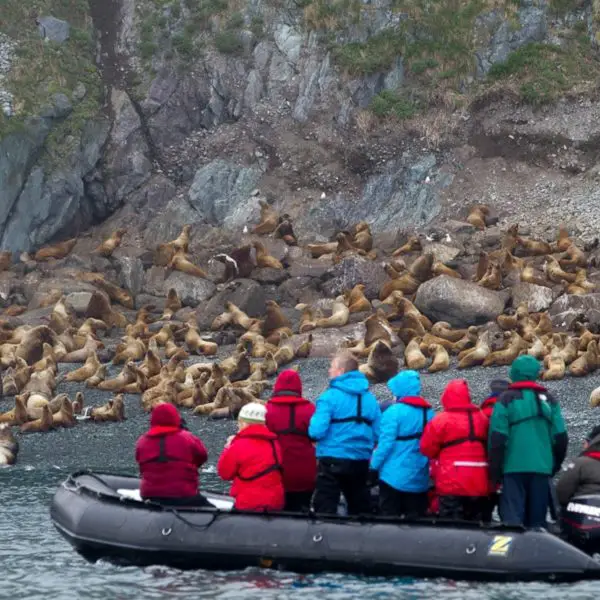
Day 1 Otaru (Japan)
Our expedition begins in Otaru, a port city in Hokkaido known for glassworks, music boxes, sake distilleries and picturesque Otaru Canal flanked with shops and cafes built within repurposed 1920s warehouses. Make your way to the designated meeting point for your transfer to Heritage Adventurer (times and meeting point will be confirmed with your voyage documents) where the captain and expedition team will be waiting to welcome you aboard. After clearing Japan Customs and Immigration, join the expedition team in the Observation Lounge or up on the Observation Deck as we set sail for Sakhalin Island. Once clear of the harbour there will be an introduction to the staff and ship, and a series of briefings. However we’ll aim to keep these as short as possible to allow you ample time to settle into your cabin and get out on deck to look for seabirds.
Day 2 Sakhalin Island (Russia)
We arrive at the Port of Korsakov on Sakhalin Island where we will clear Russian Customs and Immigration, time permitting we plan to have the opportunity to explore southern Sakhalin with the birders heading out to search for Sakhalin Leaf Warbler and Sakhalin Grasshopper Warbler as well as a number of other regional specialties which are also possible. Alternatively head into Yuzhno-Sakhalin to discover this historic town with its beautiful central park and modern cathedral. If the weather is favourable we should get great views of Tyatya Volcano, which at almost 1,819 metres dominates the landscape. This evening we sail for Kunashir Island.
Day 3 Kunashir Island
Kunashir is the largest island in the Kuril chain. The plan today will be to land ashore on Kunashir to visit the Kurilsky Reserve. Here we'll be able to explore an extensive area of woodland. A number of good walks in the island's forest interior are exceptionally productive for birding.
In the afternoon, it's time to depart the islands and head out to sea for the journey home, giving you an opportunity to recap and prepare for our arrival on land tomorrow.
Day 4 Iturup Island
If conditions are suitable we will enjoy an early morning Zodiac cruise looking for the Spectacled Guillemot and the Long-billed Murrelet. Today we plan to board the Zodiacs once again for the short ride to the community of Kurilsk where local buses will take us into the volcanic highlands of Iturup. Passing through some spectacular scenery as we steadily climb up towards the Baranskiy volcano, there may be an opportunity to soak in natural hot pools high in the mountains. The higher altitude and different vegetation gives us an opportunity to look for a range of new birds including Eastern Buzzard, Japanese Robin, Grey-bellied Bullfinch, Siberian Accentor, Pine Grosbeak and Kamchatka Leaf-warbler. On our return to Kurilsk there should be an opportunity to explore the village or explore the coastal habitats of Iturup with your naturalists including a Zodiac safari. Both Russet Sparrow and Chestnut-cheeked Starling are known to occur here and, depending on the tide, we may also find a good selection of gulls; there is often a good-sized roost here that can include Black-tailed, Slaty-backed, Glaucous-winged, Glaucous and Black-headed Gulls.
Day 5 Simushir and Yankicha Islands
After an early breakfast we plan to board the Zodiacs and cruise into a vast flooded caldera at the northern end of Simushir Island. Only a quarter of a century ago this was the location of a top secret Soviet submarine station where hundreds of mariners were based. This haunting reminder of the Cold War has now been completely abandoned and we can wander around what remains of the base, which is steadily being reclaimed by nature. Within the stunning setting of this huge caldera, we can expect to find a good range of species with one of the most common birds likely to be the spectacular Siberian Ruby-throat which can often be seen singing from the tops of scrubby bushes. Eurasian Nutcrackers also breed on the island and other species we have a good chance of encountering include Arctic Warbler, Brown-headed Thrush, Pine Grosbeak and Japanese Grey Bunting. Over lunch we plan to cruise to Yankicha Island, the summit of a submerged volcano. Invariably this is one of the highpoints of the entire voyage as the number of alcids breeding here is truly incredible. Subject to weather and sea conditions, we will use the Zodiacs to circumnavigate part of the coastline and then enter the flooded caldera. The concentrations of Crested and Whiskered Auklets here are simply spectacular and we can also expect to get great views of Brunnich’s and Common Guillemots and both Tufted and Horned Puffns. We should also see the snowy race of Pigeon Guillemot. While inside the caldera we will pass the breeding colonies of Crested and Whiskered Auklets and are likely to also find Harlequin Ducks. We also stand an excellent chance of seeing Arctic Foxes that can be pretty inquisitive as they patrol the auk colonies looking for their next meal. As we return to the ship in the late evening many of the alcids will be returning to their colonies. Being surrounded by clouds of birds darkening the sky is an experience you will never forget.
Day 6 Ekarma and Onekotan Islands
This morning we expect to be off Ekarma Island which, like so many of the islands in the Kuril chain, is an active volcano. The island is home to hundreds of thousands of breeding Northern Fulmars and we plan to Zodiac cruise along the coast enjoying the multitude of birds. Other species that breed here include both Tufted and Horned Puffns, we may even see some of the island’s resident Peregrines hunting alcids. This afternoon we plan to make a landing at the northern end of Onekotan Island from where it is a relatively easy walk to Black Lake. Our walk will take us through stunted areas of Siberian Stone Pine, Dwarf Birch and Polar Willow. At the time of our visit conditions should be spring-like and, as we make our way to and from the lake, there should be plenty of wild flowers in bloom including the possibility of some stunning orchids. On the lake a selection of wildfowl can usually be found including Greater Scaup and Goosander, while in the scrub we will be looking out for Buff-bellied Pipit, Brown-headed Thrush, Middendorff’s Grasshopper Warbler, Siberian Ruby-throat and Pine Grosbeak. On the beach where we land, and throughout the walk, there is extensive evidence of fortifications built by the Japanese during World War II. The Russians defeated the Japanese in the closing days of the war and although the islands have been considered Russian territory ever since, Japan still disputes Russian ownership of some of the Southern Kuril Islands.
Day 7 Atlasova Island, Second Kuril Strait Ptich’i Rocks
This morning we will arrive at Altasova Island where Alaid, the tallest volcano in the archipelago with an elevation of 2,340 metres, can be found. On the shore near our landing site are the remains of a Gulag and some small marshy ponds where it might be possible to see Longtoed Stint and other waders. On some nearby low cliffs there is a colony of Red-faced Cormorants and, out in the bay, there is a chance of finding Harlequin Ducks, Black and White-winged Scoters, Greater Scaup, Eurasian Wigeon and Falcated Ducks as well as Pacific Sea Otters. We then plan to sail through the Second Kuril Strait between Shumshu and Paramushir Islands on route to Ptich’i or Bird Rocks. The plan is to Zodiac cruise the wildlife rich Ptich’i Rocks where an abundance of birds, seals and Sea Otters reside at these fascinating formations. Sea Otters were hunted to almost extinction in Russia, but now number back to almost two-thirds of their historical range. Harbour and Largha Seals are often seen here as well as a healthy population of Tufted Puffins.
Day 8 Kamchatka, Russkaya Bay
Russkaya Bay is a deep fiord on the Kamchatka Peninsula where we’ll be on the lookout for the endangered Kittlitz’s Murrelet, as well as the Long-billed Murrelet.
A short excursion to the head of the fiord will give us a good chance of seeing Kamchatka Brown Bears. Cruising on the Zodiacs at the entrance to the fiord we almost always encounter Orcas and Stellar Sea Lions.
Day 9 Kamchatka, Zhupanova river
The scenic Zhupanova River is where we’ll spend several hours cruising in the Zodiacs, where we can expect to get great looks at the population of Steller’s Sea Eagles who nest in the trees along the riverbanks.
Other birding highlights may include Long-toed Stint, Kamchatka Gull, Aleutian Tern and Far Eastern Curlew. We can also pay a visit to the major salmon fishery located on the river.
Day 10 Olga Bay
Olga Bay is a part of the very large Kronotskiy Reserve, which also includes the world-famous Valley of the Geysers. The habitat is quite different to what we will have been experiencing before with lush Kamchatka forests coming right down to the beach line. There is a possibility we will see brown bears and other forest fauna, as well as multiple bird species that live in this habitat. The seas around Olga Bay are frequented by large numbers of Gray Whales that are usually quite friendly to the visiting boats, if the conditions are right we will take a Zodiac whale-watching cruise. The rising volcanoes in the background here provide a beautiful setting to explore real Kamchatka wilderness.
Day 11-12 Commander Islands
During our two days, we will explore the two main islands in the Commander group, Bering and Medny, making our way to several sites that combine the best of the island’s natural and cultural history.
On the birding front, we have an excellent chance to spot Mongolian Plover, Rock Sandpiper, Grey-crowned Rosy Finch and Pechora Pipit. We’ll also get the opportunity to observe the Commander’s endemic subspecies of Arctic Fox.
Zodiac Cruise around the island’s perimeters can be extremely rewarding, with several Auklet species and Red-legged Kittiwake. The waters surrounding the Commanders are incredibly rich in marine mammal activity. Potential cetacean species include Humpback, Sperm, Northern Minke Whale, Baird’s Beaked Whale and Orca, as well as Northern Fur Seals, Stellar Sea Lions and Pacific Sea Otters.
On Bering Island, we’ll pay a visit to the small fishing settlement of Nikolskoye and discover more about the island’s intriguing human history at the local museum.

Day 13 At sea
We have a day at sea as we cruise across the Kamchatka Trench towards Petropavlovsk- Kamchatskiy which is located at one of the greatest natural harbours in the world, Avacha Bay. These waters are renowned for cetaceans as the trench borders between two major tectonic plates creating deep canyons where these animals feed. Blue, Fin, Humpback, Sperm and Baird’s Beaked Whales have all been recorded here, as have Dall’s Porpoise and Orca, so there is real potential for some great cetacean sightings. There will, of course, also be birds to watch. Look out for Red-legged Kittiwake, Tufted Puffn, Ancient Murrelet and Fork-tailed Storm-Petrel.
Day 14 Petropavlovsk-Kamchatsky
This morning we arrive in the historic city of Petropavlovsk- Kamchatskiy, it will be worthwhile watching from one of the many vantage points as we sail into Avacha Bay. Petropavlovsk- Kamchatskiy is the main city of the Kamchatka Peninsula and the capital and administrative centre of the region. This city and the surrounding areas offer a great amount to see and explore. We encourage you to take a few extra days after the expedition to explore this amazing area, ask us about post-travel opportunities here. After a final breakfast, a coach will transfer you to a central city point or the airport.

Print this page
Save a printed version of this tour, so you can make a decision later

Send to my inbox
Email yourself or a friend the link for this tour

Ask a question
Have a question about this tour? Our experts will be happy to help
Airport arrival and departure transfers
Accommodation onboard Heritage Adventurer
3 daily meals onboard
All expeditions and shore excursions with professional leaders
Onboard lectures
Russian visa support document (invitation letter/voucher)
Travel insurance
Russian visa and visa fees. *Russian visa can be arranged by 56th Parallel for an additional cost (for Australian citizens only). Apply for concierge visa service here .
Individual transfers
Otaru to Petropavlovsk-Kamchatsky
*Price per person, based on twin share cabin
Similar tours
Kamchatka’s forgotten coast – expedition cruise.
Kamchatka's forgotten coastline is largely unspoiled by human influence. Get up close and personal as you explore this remote, pristine landscape which is home to a variety of ...
Franz Josef Land and Svalbard Cruise
Explore the many waterways and islands of this unique Arctic landscape in the Russian Arctic. Cross back through the bountiful waters of the Barents Sea and then along the coastal ...
Wrangel Island – Expedition Cruise in Russian Arctic
Truly wild and remote, Wrangel Island is the frontier of adventure cruising. This rarely-visited Arctic refuge is famed for its world's biggest population of polar bears. ...
Dowlnload comprehansive info-kit for this tour, FAQ’s and extras
Why travel to Russia with 56th Parallel?
Destination Specialists
Our team offers over 18 years of experience travelling and planning travel in Russia. Delivering outstanding travel experiences in Russia’s capitals and in some of the most stunning & remote locations takes experience, special access and the right connections. We make sure that all the fine details are handled perfectly so you can enjoy your Russia travel experience.
Group & Private Tours
The choice to join a small group on a guaranteed departure or chose to travel on your own dates with your own mates. Each destination we travel to in Russia offers an option between private tours and small group tours. Please note: on our adventure tours in remote destinations, we mostly run group tours to keep the cost down.

Bonded & Licensed
56th Parallel is a fully licensed, insured and accredited travel provider.

From USD $9,450
Day 1: Otaru (Japan)
Day 2: sakhalin island (russia), day 3: kunashir island, day 4: iturup island, day 5: simushir and yankicha islands, day 6: ekarma and onekotan islands, day 7: atlasova island, second kuril strait ptich’i rocks, day 8: kamchatka, russkaya bay, day 9: kamchatka, zhupanova river, day 10: olga bay, day 11-12: commander islands, day 13: at sea, day 14: petropavlovsk-kamchatsky, not included, start planning your tour.
A destination specialist will follow up on you enquiry shortly. Prefer to chat? Call us on +61 412 587 785 we will be delighted to be of service.
Email this tour to:
Have a question or need specific information.
Send us a note below or call us
Country * Afghanistan Albania Algeria American Samoa Andorra Angola Anguilla Antarctica Antigua and Barbuda Argentina Armenia Aruba Australia Austria Azerbaijan Bahamas Bahrain Bangladesh Barbados Belarus Belgium Belize Benin Bermuda Bhutan Bolivia Bosnia and Herzegowina Botswana Bouvet Island Brazil British Indian Ocean Territory Brunei Darussalam Bulgaria Burkina Faso Burundi Cambodia Cameroon Canada Cape Verde Cayman Islands Central African Republic Chad Chile China Christmas Island Cocos (Keeling) Islands Colombia Comoros Congo Congo, the Democratic Republic of the Cook Islands Costa Rica Cote d'Ivoire Croatia (Hrvatska) Cuba Cyprus Czech Republic Denmark Djibouti Dominica Dominican Republic East Timor Ecuador Egypt El Salvador Equatorial Guinea Eritrea Estonia Ethiopia Falkland Islands (Malvinas) Faroe Islands Fiji Finland France France Metropolitan French Guiana French Polynesia French Southern Territories Gabon Gambia Georgia Germany Ghana Gibraltar Greece Greenland Grenada Guadeloupe Guam Guatemala Guinea Guinea-Bissau Guyana Haiti Heard and Mc Donald Islands Holy See (Vatican City State) Honduras Hong Kong Hungary Iceland India Indonesia Iran (Islamic Republic of) Iraq Ireland Israel Italy Jamaica Japan Jordan Kazakhstan Kenya Kiribati Korea, Democratic People's Republic of Korea, Republic of Kuwait Kyrgyzstan Lao, People's Democratic Republic Latvia Lebanon Lesotho Liberia Libyan Arab Jamahiriya Liechtenstein Lithuania Luxembourg Macau Macedonia, The Former Yugoslav Republic of Madagascar Malawi Malaysia Maldives Mali Malta Marshall Islands Martinique Mauritania Mauritius Mayotte Mexico Micronesia, Federated States of Moldova, Republic of Monaco Mongolia Montserrat Morocco Mozambique Myanmar Namibia Nauru Nepal Netherlands Netherlands Antilles New Caledonia New Zealand Nicaragua Niger Nigeria Niue Norfolk Island Northern Mariana Islands Norway Oman Pakistan Palau Panama Papua New Guinea Paraguay Peru Philippines Pitcairn Poland Portugal Puerto Rico Qatar Reunion Romania Russian Federation Rwanda Saint Kitts and Nevis Saint Lucia Saint Vincent and the Grenadines Samoa San Marino Sao Tome and Principe Saudi Arabia Senegal Seychelles Sierra Leone Singapore Slovakia (Slovak Republic) Slovenia Solomon Islands Somalia South Africa South Georgia and the South Sandwich Islands Spain Sri Lanka St. Helena St. Pierre and Miquelon Sudan Suriname Svalbard and Jan Mayen Islands Swaziland Sweden Switzerland Syrian Arab Republic Taiwan, Province of China Tajikistan Tanzania, United Republic of Thailand Togo Tokelau Tonga Trinidad and Tobago Tunisia Turkey Turkmenistan Turks and Caicos Islands Tuvalu Uganda Ukraine United Arab Emirates United Kingdom United States United States Minor Outlying Islands Uruguay Uzbekistan Vanuatu Venezuela Vietnam Virgin Islands (British) Virgin Islands (U.S.) Wallis and Futuna Islands Western Sahara Yemen Yugoslavia Zambia Zimbabwe
If you have any urgent questions or enquiries, please give us a call +61 412 587 785
- Bahasa Indonesia
- Slovenščina
- Science & Tech
- Russian Kitchen
7 facts about the standout island in the Kuril group (PHOTOS)
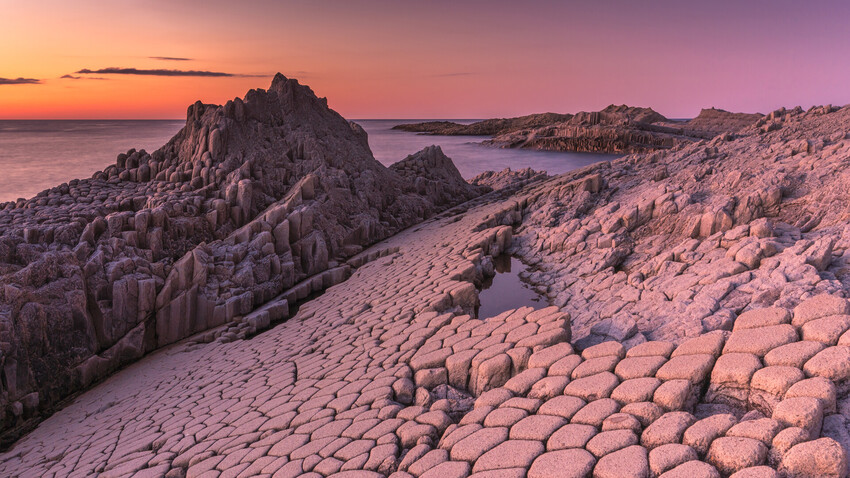
1. It’s called ‘Black Island’
Translated from a local dialect, Kunashir means ‘Black Island’. This was the name given to it by the Ainu , the ancient population of the Japanese islands, Kamchatka, the Kurils and Sakhalin. A large part of it is covered by dark green coniferous woods and almost black volcanic soil and the island’s most majestic volcano, Tyatya, casts a large dark shadow.
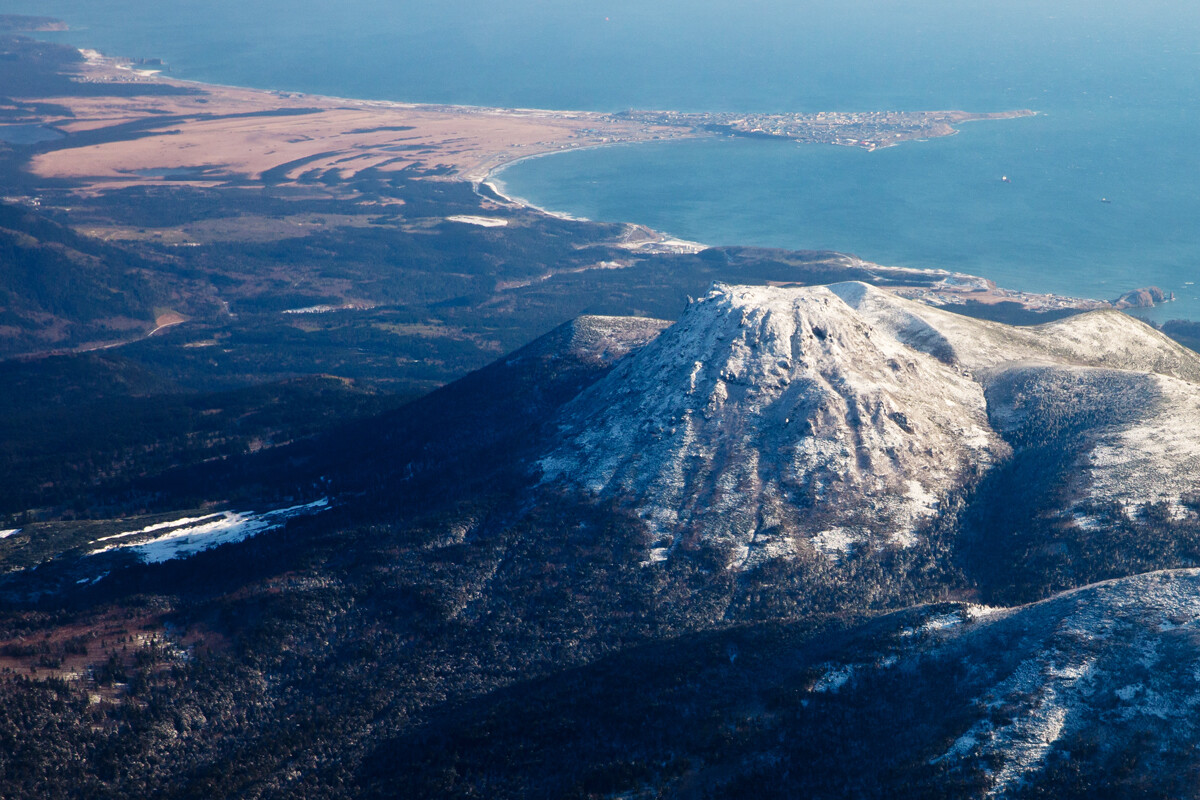
It is the most southerly of the Kuril islands. The distance from here to the Japanese island of Hokkaido is just 20 km.
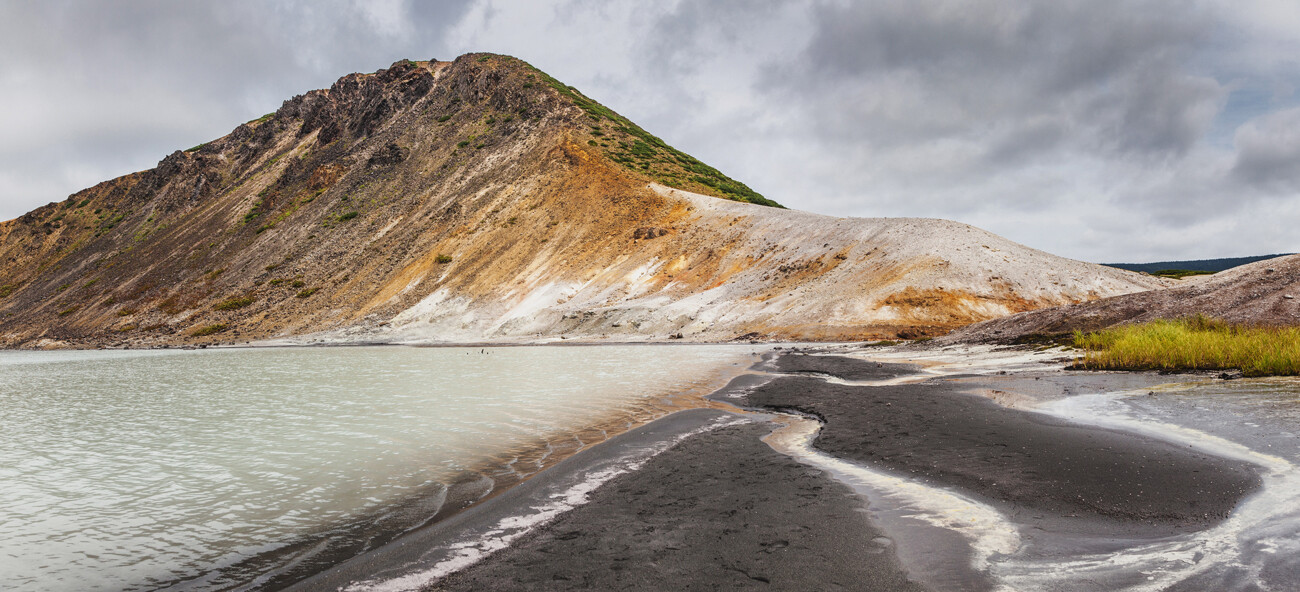
2. There are three different volcanoes (and a boiling lake)
Many are drawn to Kunashir, because in a very limited area totalling 1,490 sq. km, you can find three different types of volcanoes. They are the Golovnina caldera volcano, the complex stratovolcanoes Mendeleyeva and Ruruy, as well as the island’s calling card - the somma volcano (a volcano within a volcano), Tyatya.
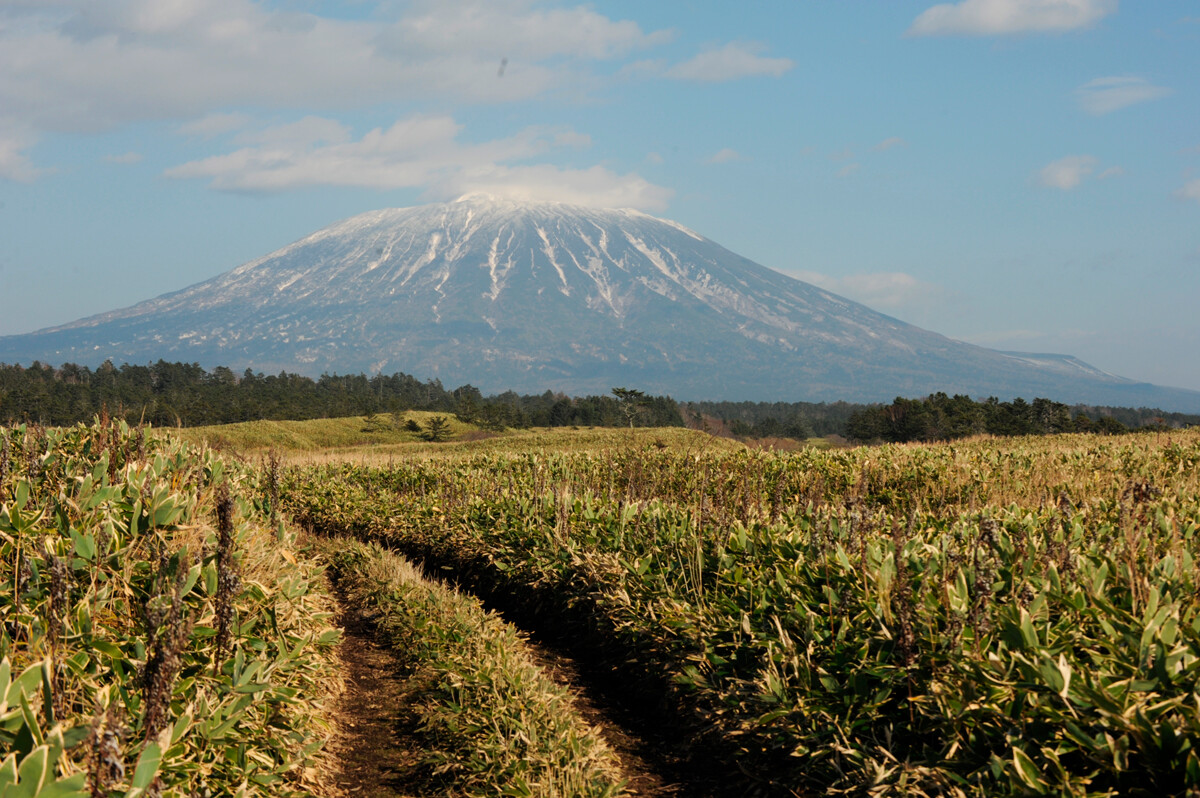
Tyatya volcano
Aside from their diverse structures, all of them have their own distinctive features. For instance, Mendeleyeva and Ruruy are famous for their hot springs. The valley formed by the volcanoes is the starting point for a stream that, lower down, forms a whole cascade of natural jacuzzis.
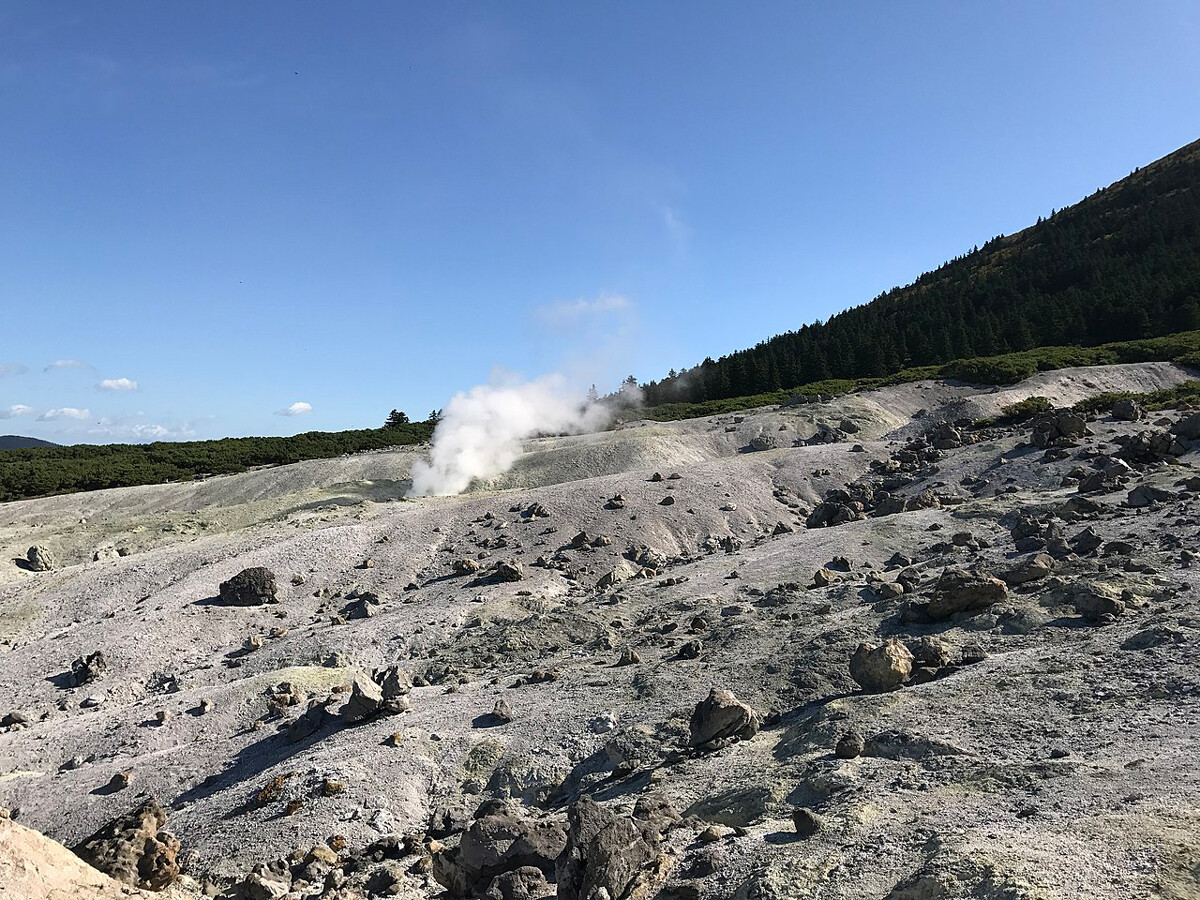
Stratovolcano Mendeleyeva
In the vicinity of the active Golovnina volcano are two lakes, Goryachee and Kipyashchee. In Kipyashchee, you can literally be boiled alive: The water temperature can get to 80°C and, in places, reaches boiling point. Jets of sulfurous and sulfur dioxide gasses are constantly being ejected under the water, keeping the temperature high. The lake’s sediments cause a black sulfidic-sulfurous foam to form on the water surface, imparting a leaden tint to the water.
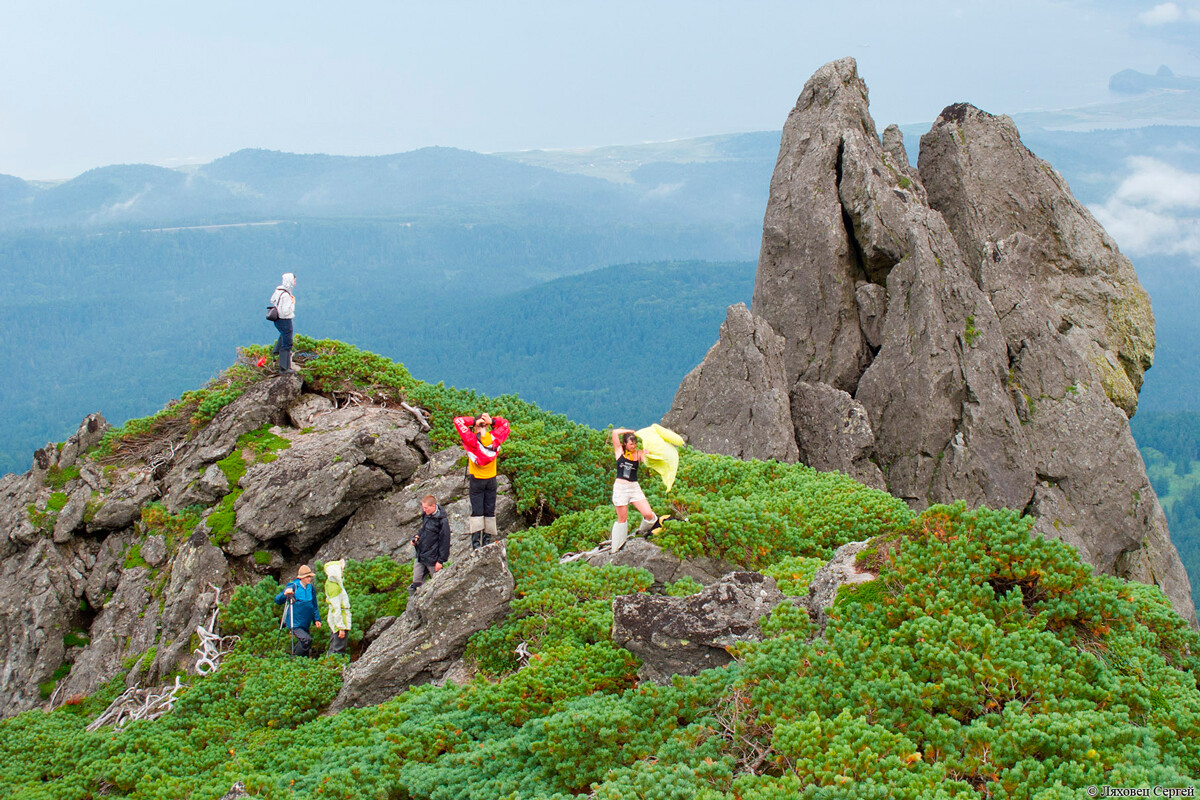
Volcano Mendeleyeva
But, you can take a dip in Lake Goryachee with its exceptional turquoise-colored water. As the two lakes are linked, the water in Goryachee is always warm.
Tyatya is the biggest and most beautiful of all the volcanoes, but it is in a remote location. You can get to its foot by motor boat, but you can only do it in good weather. If you want to walk, getting just to the foot of the volcano would take several days (and that is not factoring in the ascent of the volcano itself, which is 1,800 meters in height).
3. There is a beach here where you can bake a crab
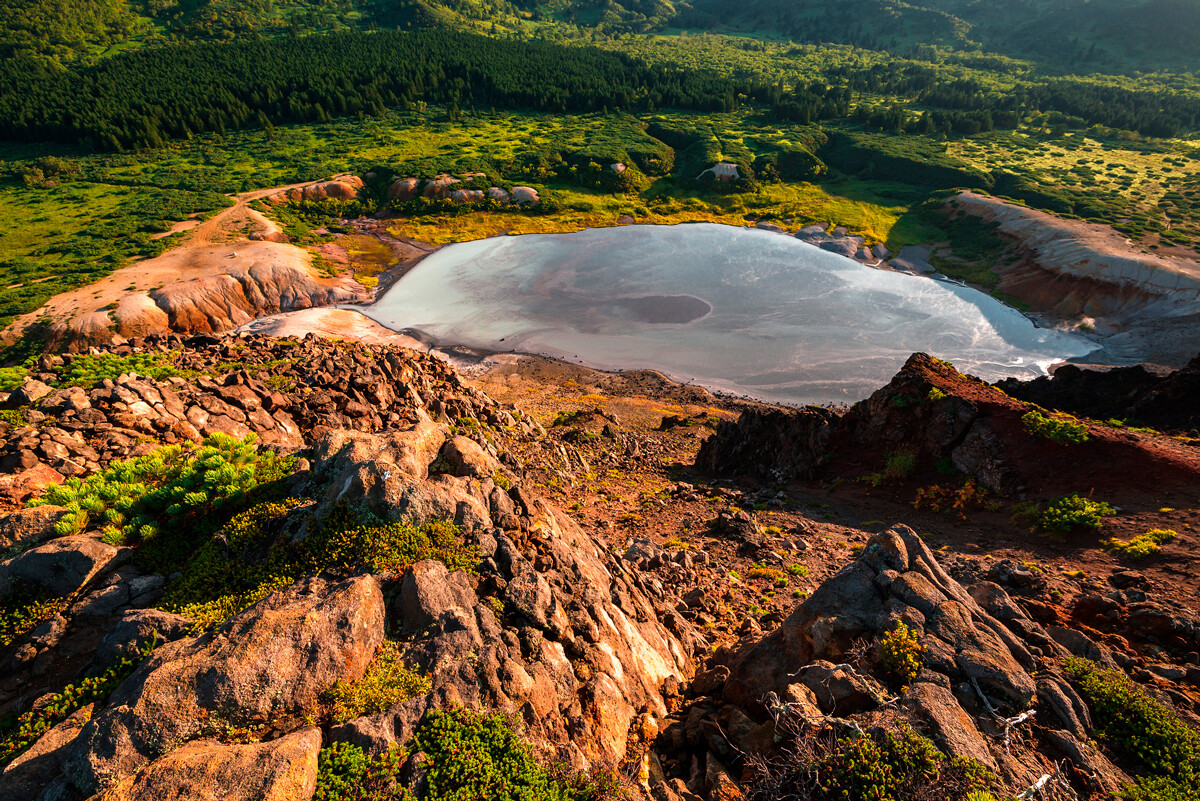
Kipyashchee lake
The location is Goryachy Plyazh at the foot of Mendeleyeva volcano. It is the only place on dry land there where the volcanic rocks are covered by a layer of sand. But the temperature of the sand is so hot that you can easily fry an egg or bake some seafood.
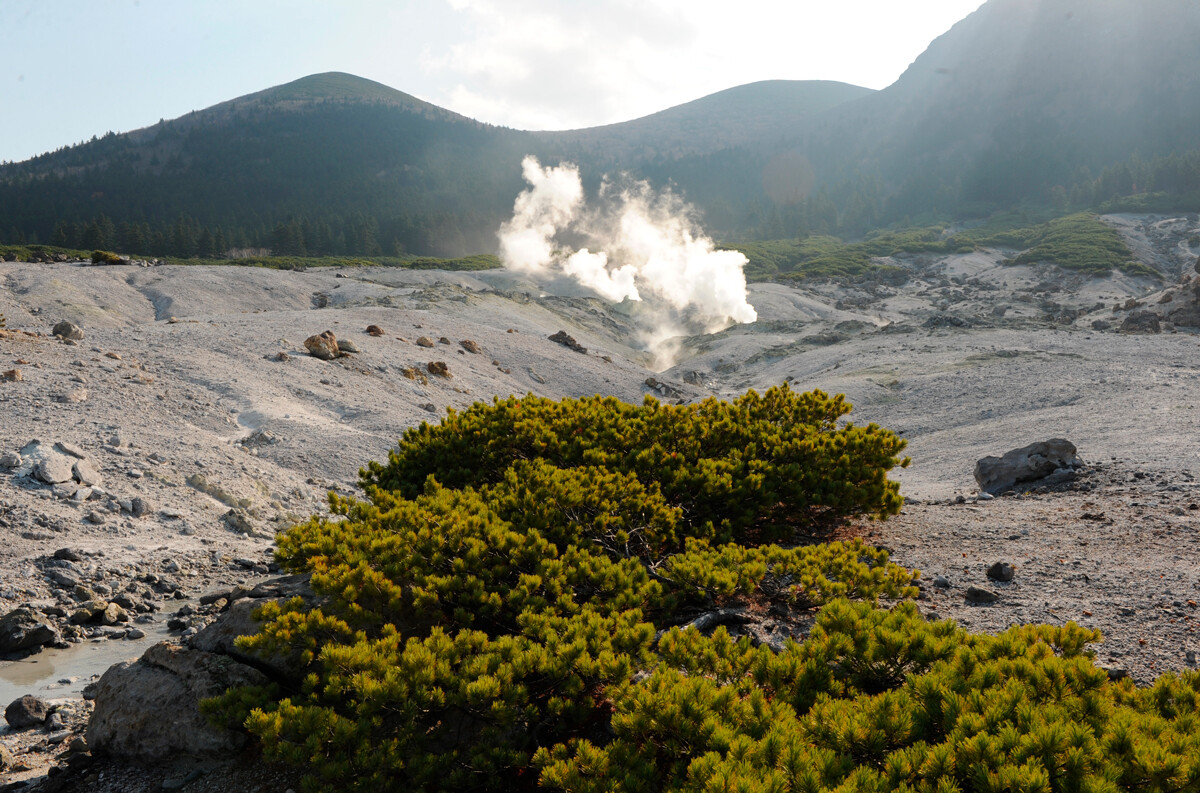
Fumar fields of Mendeleeva volcano
Most importantly, don’t get too close to the fumaroles (vents and cracks in the ground around the volcano), from which noxious yellow vapors are periodically emitted.
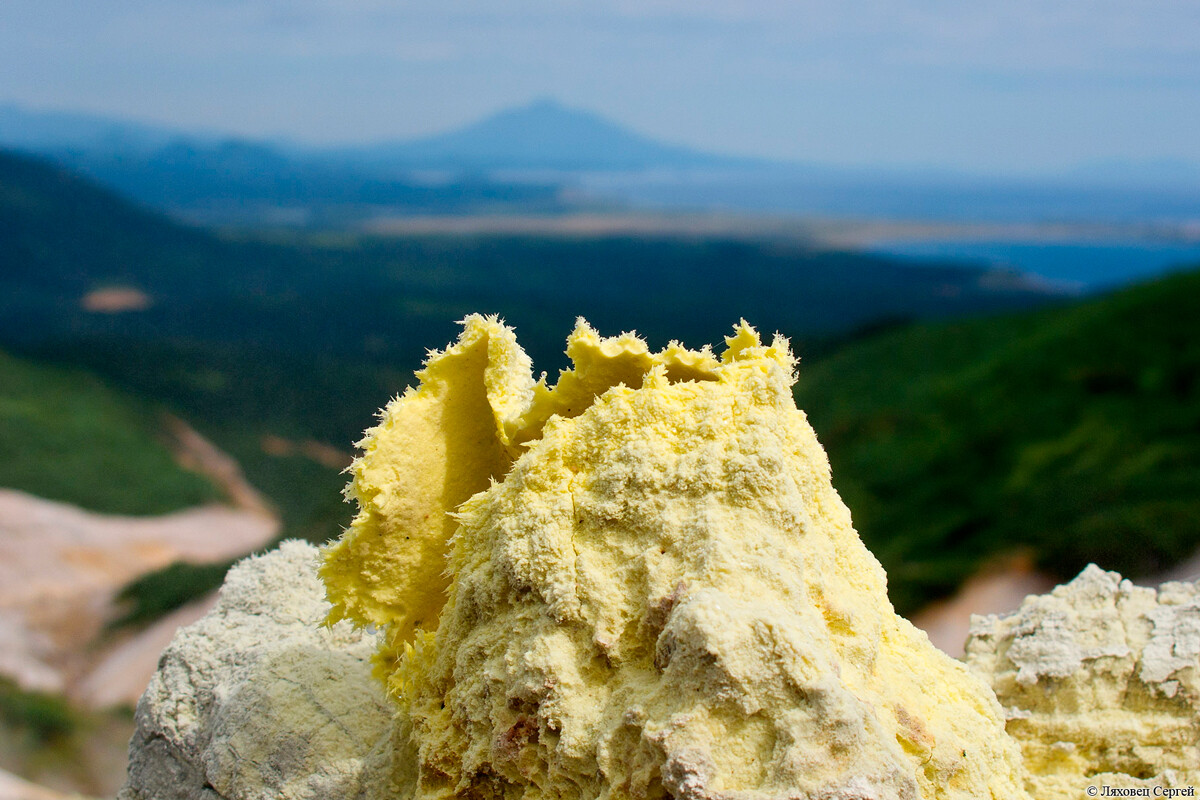
4. Cape Stolbchaty - formed by the cooling of lava
Forty to fifty million years ago it was also formed by the Mendeleyeva volcano. Lava from it poured into the ocean and solidified in the cold water to form five- or six-sided columns resembling the pipes of an organ. With the passage of time, the basalt formation rose out of the water and nature turned it into a tall and sheer headland (up to 50 meters high in places) on the shores of Kunashir.
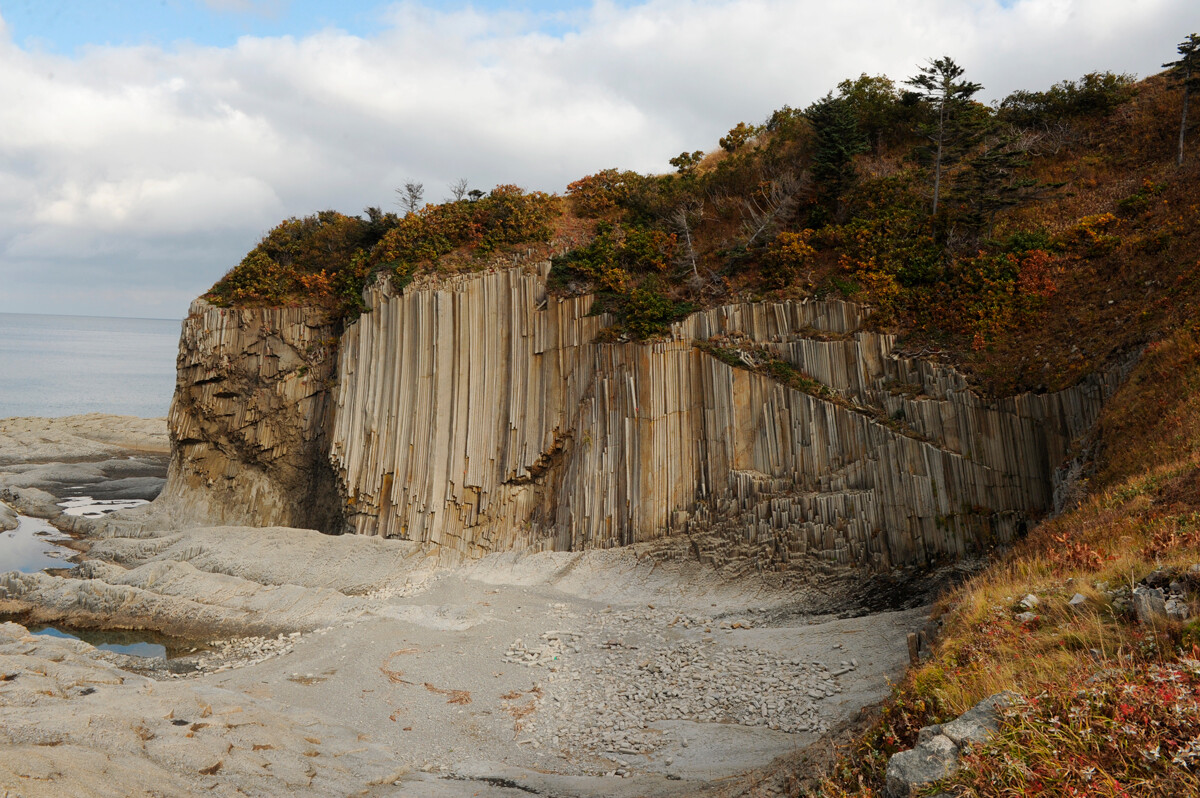
Cape Stolbchaty
The locals call it Cape Stolbchaty, meaning “Cape Columnar”, because of its characteristic structure - and regularly entertain tourists there.
5. Over half the flora are Red Book species
Kunashir is also a state nature conservation area. Species of flora grow side by side there, which, on the mainland, are never to be found in the same geographic surroundings: fir trees entangled with climbing plants and covered with mosses and bamboo next to viburnum and cedar. What’s more, over half of the flora on Kunashir is listed in the Russian Red Book of endangered species.
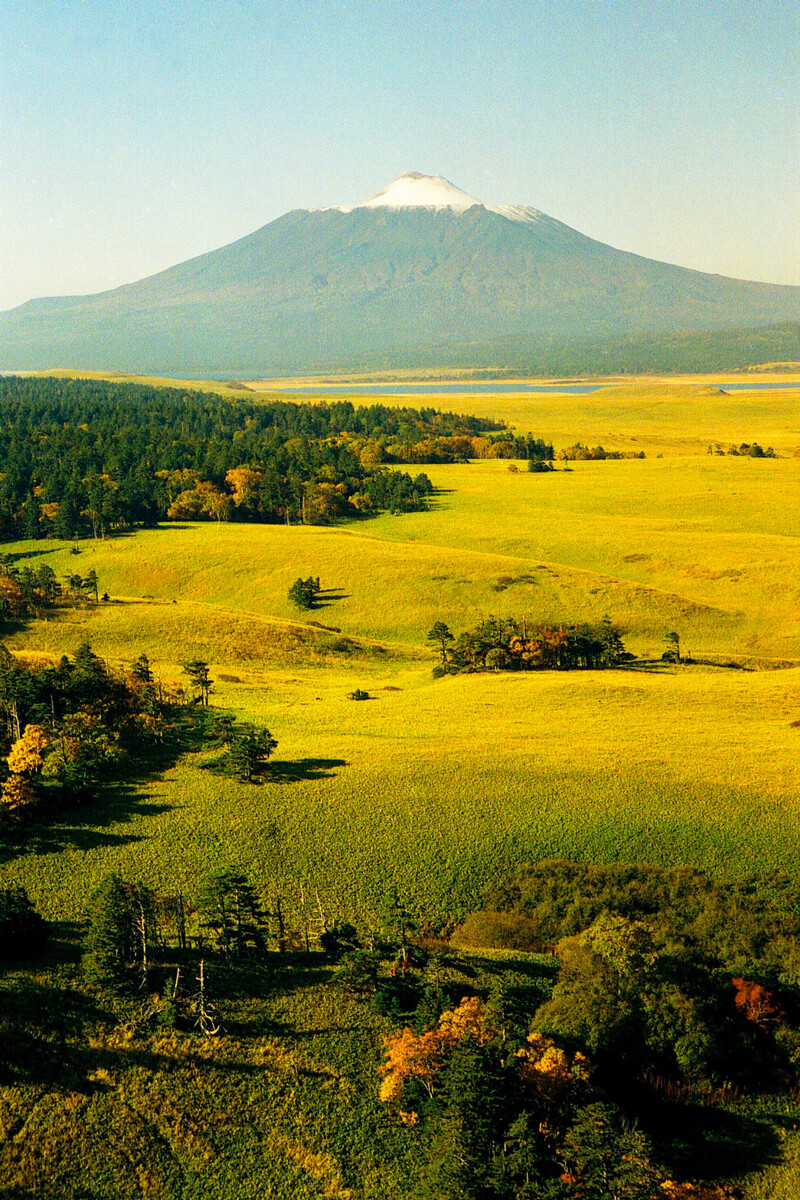
A nature trail runs across the island, along which boards with information about local endemic species can be found.
6. You can only get to Golovninsky Cliff at low tide
One of the most beautiful places on the island stretches from Cape Puzanov to the estuary of the River Belozerka. It’s called the Golovninsky Cliff and, located on the island’s Pacific shore, it consists of a long sheer wall of volcanic rock from which waterfalls gush. This wall of stratified rock reflects two million years of island history.
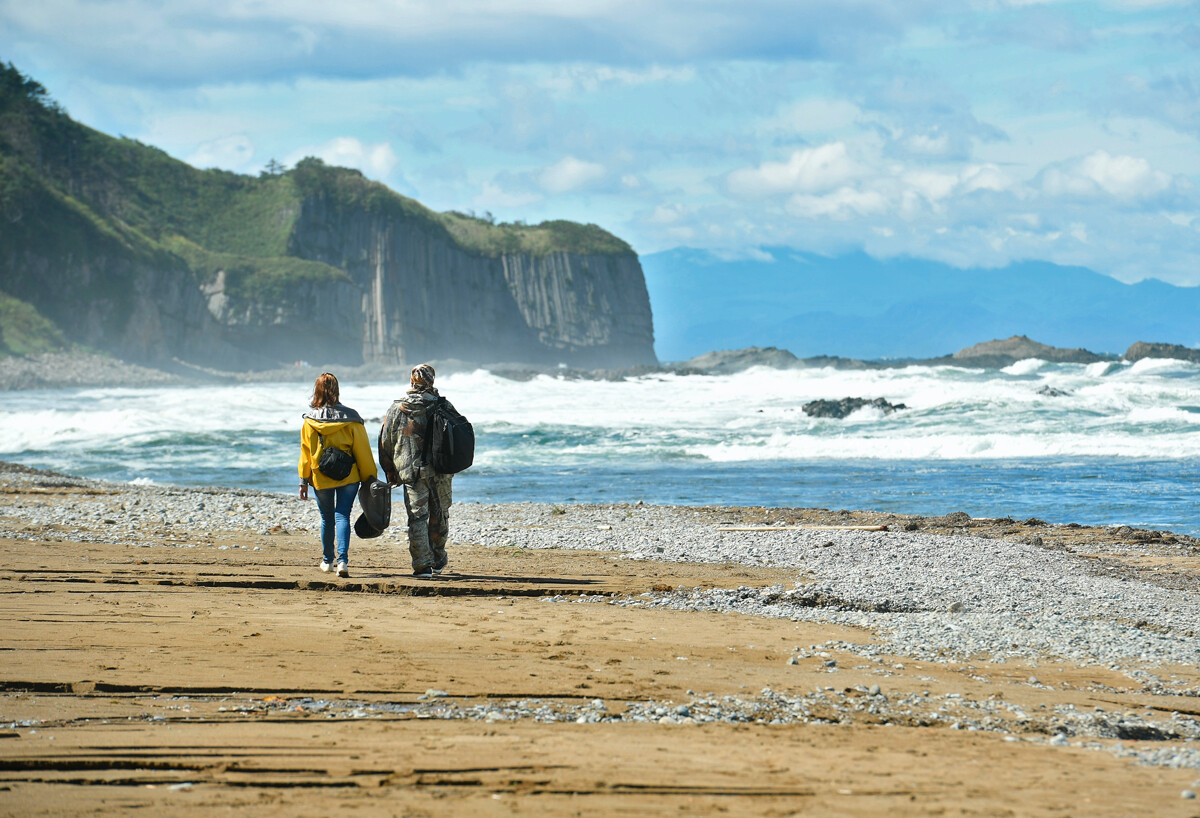
But to view this beautiful sight you have to wait for low tide: at any other time, the ocean reaches the foot of the cliff itself.
7. You’ll need a special permit to get here
Japan acquired full title to the island of Kunashir in 1875, in exchange for recognizing Sakhalin as Russian territory. But, in 1945, after the end of World War II and the signing of the Potsdam Declaration, the island passed to the Russians (although, Japan continues its attempts to assert its title to Kunashir and three other islands in the Southern Kurils). The Japanese left the island and Soviet military installations were built there.
The entire island is still regarded as a frontier zone and it is only possible to visit it with a special permit. They are issued in the district center of Yuzhno-Kurilsk, where almost the entire population of the island is concentrated. To get one, you need to apply to the conservation area’s administrative office.
If using any of Russia Beyond's content, partly or in full, always provide an active hyperlink to the original material.
to our newsletter!
Get the week's best stories straight to your inbox
- The most beautiful island monasteries in Russia (PHOTOS)
- INSIDE the most beautiful Russian mosques (PHOTOS)
- From sandboxes to castles: How children’s playgrounds in Russia evolved (PHOTOS)
This website uses cookies. Click here to find out more.

- 日本最大級 専用 超特価!Fontaine フォンテイン 12デックセット トランプ
- 専用 超特価!Fontaine フォンテイン 12デックセット
- 商品の状態 目立った傷や汚れなし
- 配送料の負担 送料込み(出品者負担)
- 配送の方法 らくらくメルカリ便 匿名配送
- 発送までの日数 1~3日で発送
64a89c045b7b47

DECK(デッキ) | HIGHSOX SKATEBOARDS

楽天市場】SHINANO SI-1460ULTRA 12.7sq.ショートノーズインパクト

WEBカタログ|バロックジャパンリミテッド 公式通販サイト SHEL'TTER

zz-C37981-1.jpg?sw=1020

4WAYマルチアウトドアクッカー モンターナ | イオンスタイル

楽天市場】レザーライダースジャケット
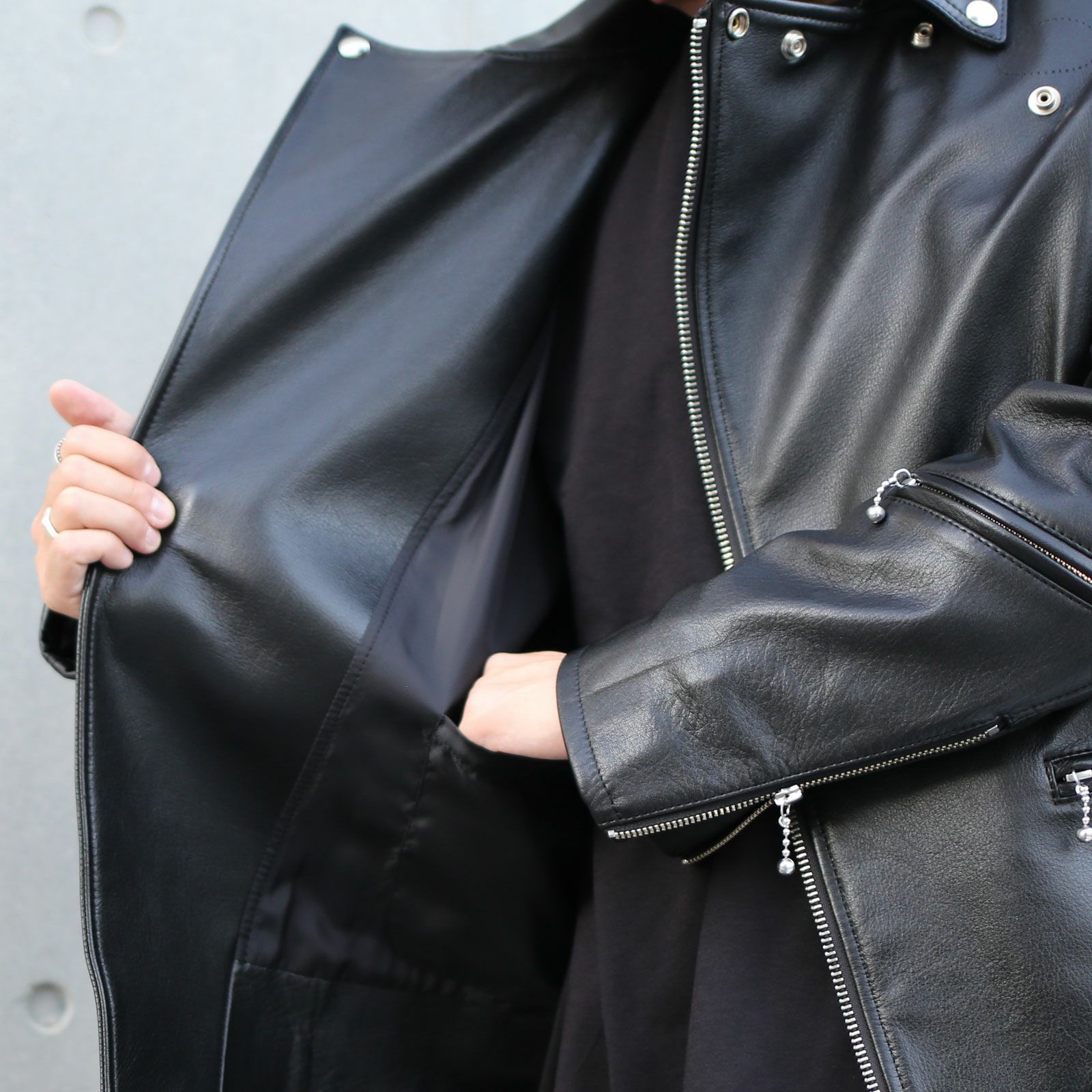
この商品を見ている人におすすめ

プライバシーと利用規約
- メルカリShops利用規約
- 個人データの安全管理に係る基本方針
- 資金決済法に基づく表示
- Facebook Created with Sketch.
Published daily by the Lowy Institute
Why Russia will not return the Kuril Islands to Japan
More than 60 years of stubborn diplomatic stalemate stemming from the Second World War doesn’t appear likely to end.
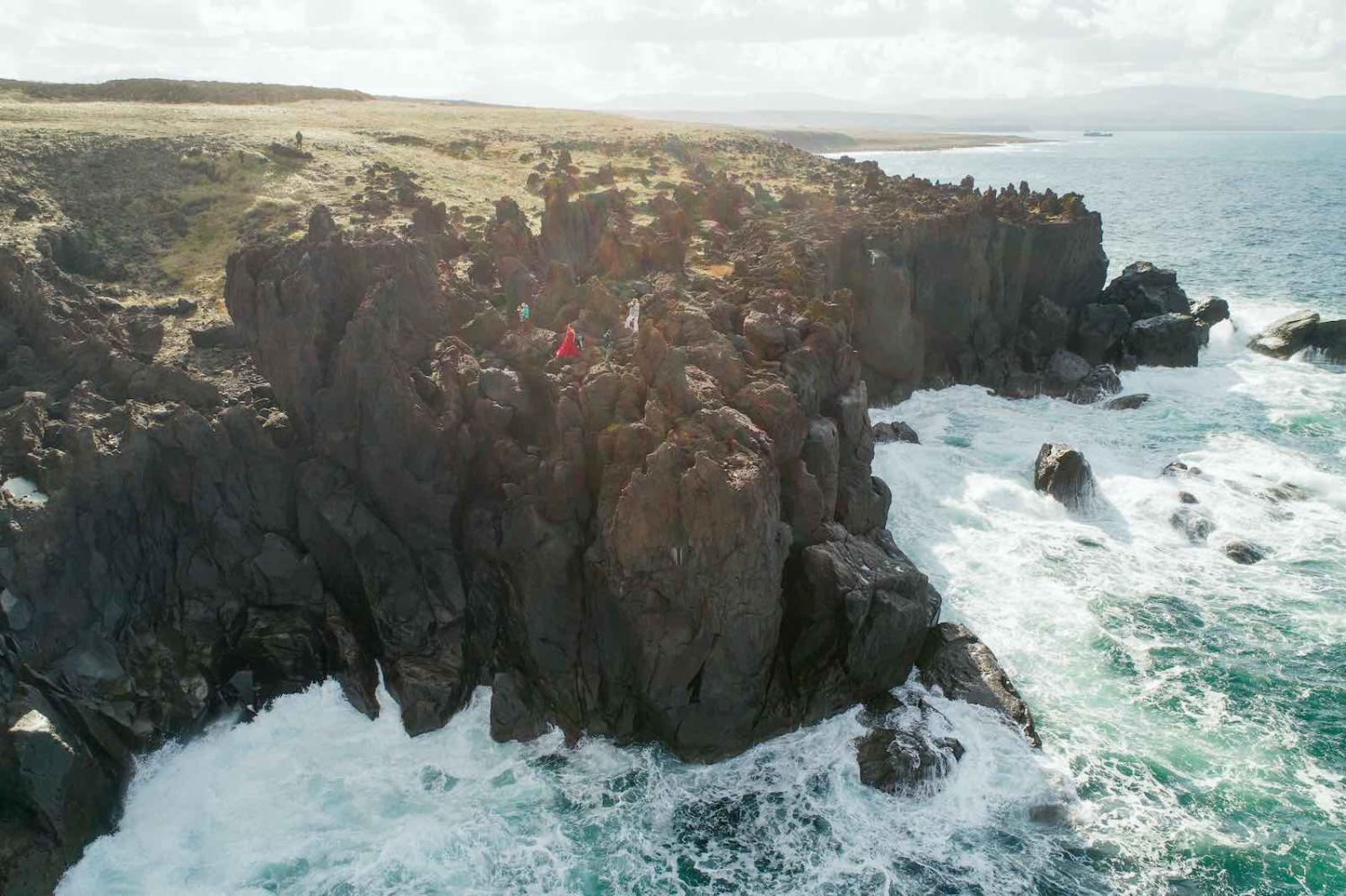
The decades-old dispute between Russia and Japan over the status of the Kuril Islands is far from over. Tokyo, which refers to the islands as the Northern Territories, still insists on a peace treaty with Moscow that would result in Russia’s return of at least two out of four islands to Japan, while the Kremlin keeps militarising the disputed territory.
The chain of islands – stretching between the Japanese island of Hokkaido at the southern end and the Russian Kamchatka Peninsula in the north – was conquered by the Soviet Union at the end of the Second World War. Ever since, Moscow has considered the Kuril Islands an integral part of Russia. Japan thinks otherwise.
The four islands are variously known in Russia and Japan as either Shikotan, Habomai Islets/Khabomai, Kunashiri/Kunashir and Etorofu/Iturup. In 1956, the Soviet Union and Japan signed a joint declaration providing for the end of the state of war, and for restoration of diplomatic relations between USSR and Japan. The document also included a transfer of Habomai and Shikotan to Japan. But a dispute has lingered with no formal peace treaty between the two nations. Russia is the successor state of the Soviet Union, and it leaders have said on several occasions that they were ready to have territorial talks with Japan on the basis of the joint declaration.
The most recent talks between Russia and Japan over the status of the islands were held in early 2019 . Japan’s then prime minister Shinzo Abe and Russian President Vladimir Putin had agreed to accelerate negotiations based on the 1956 document, which stated that the Habomai islets and Shikotan would be handed back to Japan, and the question of Kunashiri and Etorofu was to be settled during negotiations for a peace treaty.
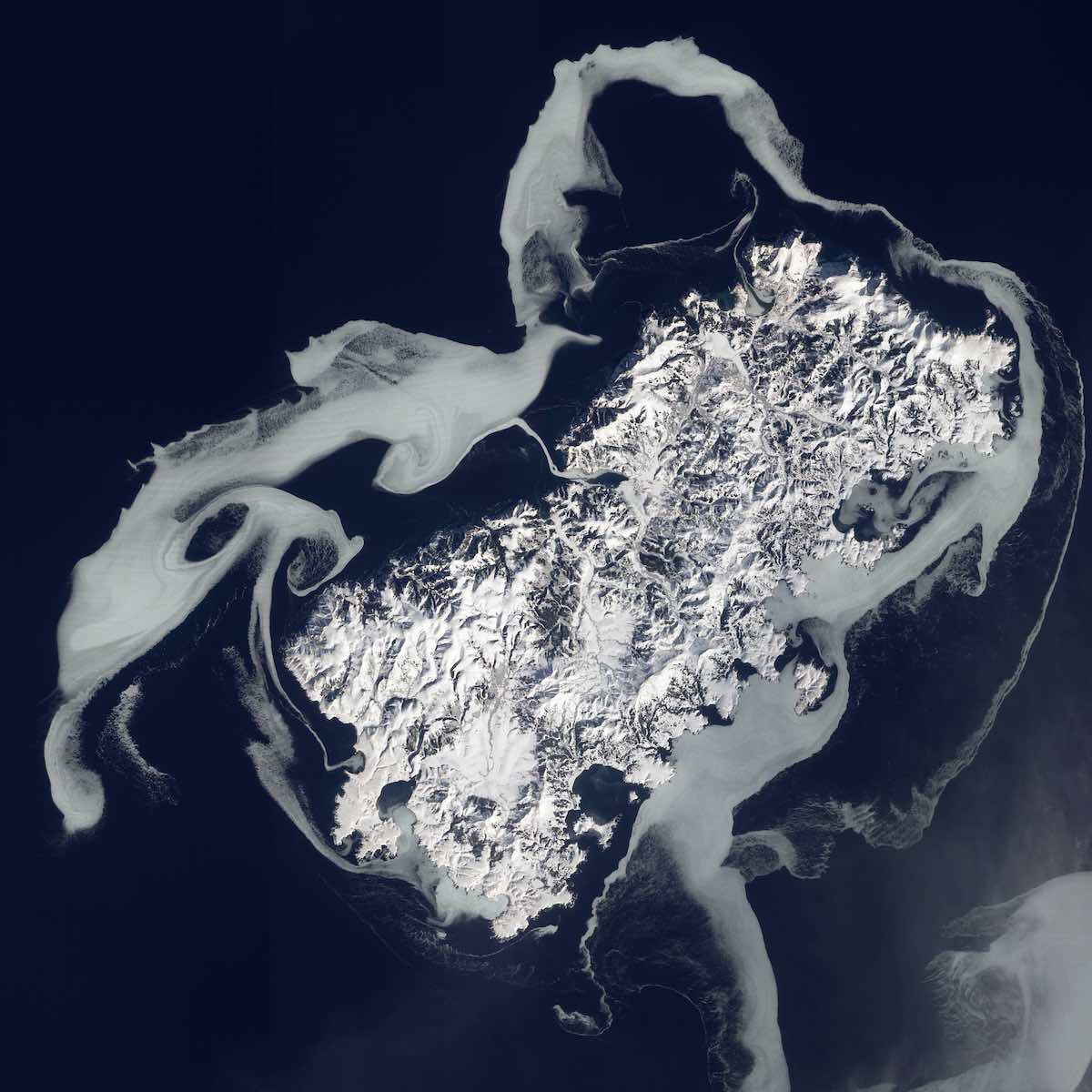
Indications that the Kremlin was willing to discuss the status of Habomai islets and Shikotan was seen by some Russian nationalists as a treason, particularly in Sakhalin Oblast, the region which comprises the island of Sakhalin and the Kuril Islands. Recent constitutional changes in Russia suggest this view has only hardened. Even though the two islands represent only 7% of the land in question, the new Russian constitution enacted in July this year includes a ban on “any alienation of Russian territories”. This would seem to preclude the return of even one square metre of Russian territory to Japan.
Japanese leaders, on the other hand, claim that the Russian Federation, as the legal successor to the Soviet Union, is obliged to scrupulously observe all of past obligations, including the unfulfilled subparagraph on the territorial issue. Japan’s Prime Minister Yoshihide Suga recently said Tokyo plans to finalise the talks on the dispute.
“We need to achieve closure in the talks on the Northern Territories, instead of postponing it for future generations,” Suga said, and pointed out that he will strive for “comprehensive development of relations with Russia, including the signing of a peace agreement”.
A potential return of the Kuril Islands to Japan would be interpreted as a clear sign of Russian weakness, which means that Moscow could also face strong pressure from the West to return Crimea to Ukraine.
All this ambition seems likely to go unfulfilled. And such a conclusion doesn’t only spring from more than 60 years of diplomatic stalemate, but also the stubborn facts of control on the ground.
Russian troops periodically conduct military drills on the disputed islands and may indeed go further. The Kremlin reportedly plans to deploy T-72B3 battle tanks to the Kuril Islands, where they can be used to destroy enemy assault forces and small enemy ships. In October, Russia deployed S-300V4 air defence missile systems to the territory for the first time to conduct military exercises. Although no one really expects Japan would invade the islands, Moscow clearly wants to make a show it does not intend to hand them over, either. With thousands of US troops already stationed in Japan, it’s not beyond some Russian analysts to speculate that Washington could establish naval bases in the Kuril Islands once Moscow and Tokyo resolve their territorial dispute.
Plus there is the potential wealth. The islands are surrounded by rich fishing grounds and are thought to have offshore reserves of oil and gas – although the value of such hydrocarbon claims are speculative . In addition, rare rhenium deposits have been found near the Kudriavy volcano on Etorofu.
Finally, a potential return of the Kuril Islands to Japan would be interpreted as a clear sign of Russian weakness, which means that Moscow could also face strong pressure from the West to return Crimea to Ukraine. Such a process would not only mean Russian humiliation in the global arena, but could also result in a serious political crisis that could lead to a breakup of the Russian Federation.
The prospective blow to Russian prestige therefore makes the territory is too important for the Kremlin to hand it over to Japan.
Related Content

Japan risks its reputation in Oceania with Fukushima discharge
You may also be interested in, why australia should send more military advisers to afghanistan, strategic trends across the indo-pacific region, malcolm turnbull: ruling the void.
Why the Kuril Islands are so important
Leaders of Japan and Russia holding landmark summit over the long-disputed archipelago
- Newsletter sign up Newsletter
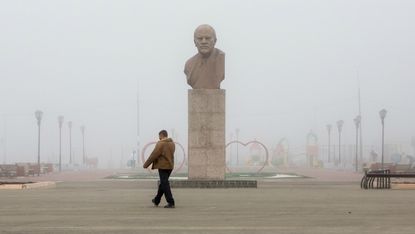
Officials from Russia and Japan are meeting today discuss the sovereignty of the disputed Kuril Islands, in a bid to resolve a diplomatic dispute that has raged for decades.
Japan launches search for ‘missing’ island Why Vladimir Putin is topping calendar sales in Japan VE Day: how World War 2 ended
The southernmost four islands of the remote archipelago, situated north of the Japanese island of Hokkaido, were seized by the Soviet army in the closing days of the Second World War as part of a surprise attack on Japan, which has never formally recognised Russia’s claims to the land.
The Times reports that because of this dispute, the countries have never signed a peace treaty officially ending the War, preventing political and economic cooperation.
Subscribe to The Week
Escape your echo chamber. Get the facts behind the news, plus analysis from multiple perspectives.

Sign up for The Week's Free Newsletters
From our morning news briefing to a weekly Good News Newsletter, get the best of The Week delivered directly to your inbox.
Now, international observers are hoping that Russian President Vladimir Putin and Japanese Prime Minister Shinzo Abe can finally reach some form of resolution, during talks today in Moscow where the status of the Kuril Islands is “expected to be high on the agenda”, says news agency Sputnik .
But while the two leaders have been “making optimistic noises for months about a compromise over the islands”, such hopes “have receded in recent days amid tough talk from Moscow”, adds The Times.
President Putin is facing growing pressure to reject any claims by Japan, following protests in the Russian capital this weekend during which hundreds of citizens chanted “Kurils are Russian land”, CNN reports.
So why exactly have the islands caused so much friction?
Where are the Kuril Islands?
The Kuril Islands are a chain of 56 islands stretching from the southernmost tip of the far eastern Russian oblast of Kamchatka to Hokkaido, the northernmost island of Japan. The chain separates the Sea of Okhotsk from the north Pacific Ocean.
Russian empress Catherine the Great claimed sovereignty over the Kuril Islands in 1786 after her government declared they were discovered by “Russian explorers” and therefore “undoubtedly must belong to Russia”, Arab News reports. The first treaty between tsarist Russia and Japan, signed in 1855, stipulated that the border between the two countries be drawn just north of the four islands closest to Japan - Iturup, Kunashir, Shikotan and Habomai.
In 1875, a new treaty handed Japan the entire archipelago in exchange for Russia gaining full control of the nearby island of Sakhalin.
But Japan seized back control of the southern half of Sakhalin in 1905 after claiming victory in the Russo-Japanese War - sparking tensions that would resurface at the end of the Second World War, when the Soviet Union took control of the entire chain following Japan’s surrender.
Although Japan recognises Russia’s sovereignty over the majority of the islands, it continues to insist that Moscow’s claims over the four southernmost islands are illegal.
Why are the islands important?
Although the entire island chain has a total population of only around 20,000 people, the South Kurils are of significant strategic importance to Russia owing to their location. Because the strait between Kunashir and Iturup does not freeze over in winter, control of the islands ensures Russia has year-round access to the Pacific Ocean for its Pacific Fleet of warships and submarines based in Vladivostok.
Arab News reports that Russia has also constructed military bases on the archipelago and has deployed missile systems on the islands, which are “rich in hot springs and minerals and rare metals such as rhenium”, used in the production of supersonic aircraft.
What do the two countries say?
In 1956, the Japan-Soviet Joint Declaration saw Russia propose returning the two islands closest to Japan as tensions eased, but Tokyo rejected the deal, in part because the two islands represent only 7% of the land in question, the BBC reports.
However, Al Jazeera reports that Putin and Abe “agreed in November to accelerate negotiations” based on the 1956 proposal, with Abe said to be considering abandoning hope of getting back the larger islands of Kunashir and Eturup.
But in recent days Russian officials have shifted away from the idea of an agreement between the two countries, with Foreign Minister Sergei Lavrov seemingly trying to “temper Japanese expectations of an imminent deal”, the news site adds.
Lavrov, Moscow’s top diplomat, told reporters last week that “sovereignty over the islands was non-negotiable”, adding: “This is Russia’s territory. This is our basic position and without a step in this direction it is very hard to expect progress on other issues.”
“Japan is the only country in the world that cannot fully recognise the outcome of World War Two,” Lavrov added.
Japan Today notes that the Kremlin “has ridden a wave of nationalism following Moscow’s annexation of Crimea from Ukraine in 2014, and any attempt to structure an agreement with Japan around a territorial compromise would likely be poorly received”.
But Moscow says Tokyo is “distorting” information about today’s talks in order to push its agenda in claiming Kunashir and Eturup, reports RT, formerly Russia Today . Putin has said the wording of the 1956 declaration is too “vague” to form the basis of a legitimate handover, the Moscow-based news site adds.
Meanwhile, Al Jazeera says that relations between Japan and Russia may have soured as a result of recent comments by Japanese foreign minister Taro Kono, who reportedly suggested that solving the territorial dispute with Russia would help efforts by Japan and the US to “deter China”.
Lavrov called that claim “outrageous”, adding that it raised new questions about the independence of Japanese foreign policy.
“We wondered whether Japan could be independent given such reliance on the US and we were told that Japan would act proceeding from its national interests,” Lavrov said. “We would like to hope it will indeed be so.”
Sign up for Today's Best Articles in your inbox
A free daily email with the biggest news stories of the day – and the best features from TheWeek.com

The Week Recommends As the price of this store cupboard staple has rocketed, we look at ways to save and other oils to use for cooking
By Adrienne Wyper, The Week UK Published 22 April 24

Talking Point Met Police accused of 'two-tier policing' by former home secretary as new footage emerges of latest flashpoint
By The Week UK Published 22 April 24

Today's Newspapers A roundup of the headlines from the US front pages
By The Week Staff Published 22 April 24
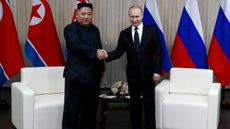
Today's Big Question Putin wants to boost ‘depleted stocks’ but Pyongyang’s arms may be in poor condition
By Chas Newkey-Burden Published 5 September 23

Today's Big Question Russia deploys crack paratroopers to try to stall key Ukrainian advances
By Arion McNicoll Published 30 August 23

Speed Read Pyongyang warned Washington of ‘shocking’ repercussions over alleged spy planes
By Arion McNicoll Published 12 July 23

feature And other stories from the stranger side of life
By Chas Newkey-Burden Published 5 June 23
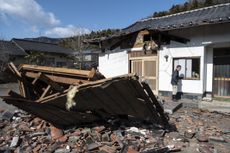
Speed Read Supply of nutritional supplements and drinks would be unlocked in the event of a major disaster
By Chas Newkey-Burden Published 2 June 23
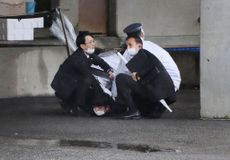
By Justin Klawans Published 15 April 23
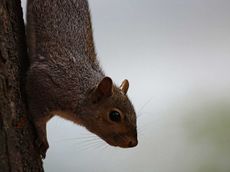
By Chas Newkey-Burden Published 4 April 23
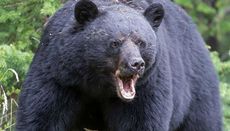
By The Week Staff Published 3 April 23
- Contact Future's experts
- Terms and Conditions
- Privacy Policy
- Cookie Policy
- Advertise With Us
The Week is part of Future plc, an international media group and leading digital publisher. Visit our corporate site . © Future US, Inc. Full 7th Floor, 130 West 42nd Street, New York, NY 10036.
The Kurils: A difficult life on the disputed islands
Locals say life is tough and development slow as Russian and Japanese leaders fail to come to agreement over dispute.
![kuril islands travel Kuril Islands [Nikolay Korzhov/Al Jazeera]](https://www.aljazeera.com/wp-content/uploads/2016/12/154586207bae4259895ad1a7887a257b_18.jpeg?resize=770%2C513&quality=80)
Kurilsk, Russia – Kurilsk is a bleak and ominous town with dozens of wooden houses scattered among the mounds of snow. It is the largest settlement on Iturup Island, which lies between Japan’s Hokkaido Island and Russia’s Kamchatka and belongs to the Kuril Islands chain.
In the winter, Iturup is nearly impossible to reach. There is a ferry from port Korsakov on Sakhalin Island that runs every two weeks and the whole commute takes up to 20 hours. The flights are also irregular and are often delayed for four to five days due to the weather conditions.
The Kurils are strategically important for Russia. It has a number of military bases on the islands, which also guarantee secure access to the Pacific Ocean through the the Sea of Okhotsk.
Russia has included social and economic development programmes approved since 2014 for the development of these territories in its federal budget, allocating almost 70 billion roubles ($1.1bn) to the cause.
According to the “Social and economic development of the Kuril Islands (Sakhalin region) 2016-2025”, priority is given to the development of a transportation system, infrastructure and the improvement of living conditions. The development plans are ambitious but locals complain that they have yet to any effect on unemployment, low salaries and a lack of roads.
The island is rich in natural resources, including unique reserves of rhenium on the Kudryavy volcano, but the main profit comes from the fishery industry and the production of fish roe. The delicacy is quite popular in Russia although it is much cheaper than caviar.
WATCH: Japan and Russia seek resolution over century old island dispute
![kuril islands travel Some residents have turned to poaching to harvest fish roe and earn an extra income [Andrey Kovalenko /Al Jazeera]](https://www.aljazeera.com/wp-content/uploads/2016/12/be74d71391304020a30a38c27d7ea656_18.jpeg)
Just surviving
Roman Rasskazov, a coal shoveller, who has been living on the island for more than 25 years says that poaching for fish has become common as residents try to make extra income from the fish roe.
“You might get fined or even arrested for poaching, but it’s worth risking and everyone does it here. I have to work at two jobs to make ends meet,” he says, because the cost of living is very high.
“No one could ever think about it back in the day because people had access to all the fish in the river, but now it’s quite common to poach.”
This year, Rasskazov says he harvested more than 500kg of fish roe. It costs about 2,000 roubles ($32) a kilo in a local shop, but he has cultivated a network of trustworthy buyers and sells his product much cheaper than the retail price.
Rasskazov drives a 20-year-old Japanese off-road vehicle – the only viable means of transportation across the island. “There are even no gas stations so we have to buy the diesel oil stolen from the factories where we work,” he says.
![kuril islands travel Locals say living costs are expensive while are salaries low, forcing them to work several jobs to make ends meet [Andrey Kovalenko/Al Jazeera]](https://www.aljazeera.com/wp-content/uploads/2016/12/2b4ce93638534d90acb3ddbfde7acf29_18.jpeg)
Gydrostroy is one of the main employers on the island. They have built a hospital, a kindergarten and a couple of years ago, the airport in Kurilsk. However, the majority of locals say that it’s hard to get a job there, the salary is not competitive, and most of their jobs are taken by migrant workers.
“The population of the island is too low and most of the work is seasonal, so we are forced to bring people from elsewhere. To make a person interested in the job, we need to pay them as much as we do the locals,” says Yury Svetlikov, the general manager of Gydrostroy.
“We are a socially responsible business and we have different guarantees for our employees,” Svetlikov says.
“Recently, we’ve been able to witness positive changes on the island. At least there are asphalt roads now so women can wear high heels because before there were clouds of dust,” he adds.
OPINION: Kaliningrad: The last wall in Europe
![kuril islands travel Residents of Kuril islands say infrastructure development is slow to reach them [Andrey Kovalenko/Al Jazeera]](https://www.aljazeera.com/wp-content/uploads/2016/12/9bced1685bf44a17a18a4252e8424f17_18.jpeg)
A decades-old territorial dispute
“I have been interested in Japan since university and I always wanted to go there,” says Ksenia Vinogradova. She is a young, enthusiastic research fellow at the local museum. Vinogradova came to Iturup two years ago and immediately became involved in local community activities.
There’s a special tourist exchange programme that allows small groups of tourists with local registration to travel to Japan without a visa, and Vinogradova has gone on several such trips.
“During my first trip we met Japanese colleagues and worked on an archaeological site,” Vinogradova says. “Apart from work, we managed to establish very warm and friendly relations.”
The opportunity to undertake such a trip and meet Japanese people is more than just an academic and touristic affair. But Vinogradova does not want to discuss the issue that underlies the main political confict surrounding the islands.
The Kuril Islands were annexed by the Soviet Union in aftermath of the Kuril Islands landing operation at the end of World War II. The territorial dispute prevents Russia and Japan signing a formal peace treaty. Japan lays claim to four islands: Habomai, Shikotan, Kunashir and Iturup.
“We’d better work on something together with our Japanese colleagues rather than thinking about arguments,” Vinogradova says.
Before his official visit to Japan, President Vladimir Putin said in an interview with Bloomberg that Russia does not “trade in territories”. Many specialists agree that Russia is not going to give up any of the islands in exchange for greater economic cooperation.
“All the negotiations should be based on the treaty of 1956 which was ratified both by the Supreme Soviet of the USSR and by the Japanese parliament. It’s the most logical decision right now,” says Tamerlan Abdikeev, the founder INVERO Advisors, a consulting company based in Tokyo.
“There are several problems, such as the Russian military bases on the islands or the possible placement of American military bases if Japan gets any of the islands which will definitely not be accepted by Russia,” adds Tamerlan.
“We need to understand that without solving the Kuril Islands dispute there will be no boost in economic cooperation between two countries. It’s hard to expect mutual trust without signing a peace treaty between two countries.”
Rasskazov, the poacher and coal worker, feels strongly about maintaining the territorial integrity of Russia. “I don’t think we’ll give up any of the islands,” he says.
“Putin is not Ekaterina [Ekaterina the second, empress of Russia], he’s not going to give away a piece of land. If you give away one, the Poles will claim some territories, the Finns will claim some. There’ll be nothing left of Russia.”
But, maintaining the status quo, means that the chances of change are small.
“With the amount of money that the government invests in the region there should be a completely new town here. I don’t know who’s responsible for that but I don’t understand what the government thinks of. People are basically surviving here,” says Rasskazov.
Japanese Prime Minister Shinzo Abe hosted Vladimir Putin in Japan on December 15, but the two leaders failed to come to an agreement over the disputed islands and the meeting ended in a stalemate.
![kuril islands travel [Andrey Kovalenko/Al Jazeera]](https://www.aljazeera.com/wp-content/uploads/2016/12/d3c316ad5f884184b88c658afcdf8afe_18.jpeg)

IMAGES
VIDEO
COMMENTS
The Kuril Islands ( Russian: Кури́лы, koo-REE-lyh; Japanese: Chishima Islands, 千島列島, Chishima Rettō ), are a chain of islands in the Russian Far East, located directly to the north of Hokkaido, Japan, east of Sakhalin and southwest of Kamchatka . Although most of Kuril Islands are the subject of a territorial dispute between ...
These Far-Flung Islands Are Literally a Travel Hot Spot. The Kuril Islands sit atop a seismic region in the Pacific known as the "Ring of Fire," which has produced this chain that features over 100 volcanoes, more than 35 of which are still active. Do not forget your camera because a sail through the Kurils puts a diverse range of ...
There are 56 islands and many minor islets. The Kuril Islands consist of the Greater Kuril Chain and, at the southwest end, the parallel Lesser Kuril Chain. [2] They cover an area of around 10,503.2 square kilometres (4,055.3 sq mi), [3] with a population of roughly 20,000. [4]
Things to Do in Kuril Islands, Russia: See Tripadvisor's 100 traveler reviews and photos of Kuril Islands tourist attractions. Find what to do today, this weekend, or in April. ... Restaurants Flights Travel Stories Cruises Rental Cars More. Tours Add a Place Airlines Travelers' Choice Help Center $ USD. United States
Kuril Islands Tourism: Tripadvisor has 100 reviews of Kuril Islands Hotels, Attractions, and Restaurants making it your best Kuril Islands resource. ... Things to Do Restaurants Flights Travel Stories Cruises Rental Cars Tripadvisor Plus More. Tours Add a Place Airlines Travelers' Choice Help Center.
Travelers going to the Kuril Islands arrive most quickly via plane from Yuzhno-Sakhalinsk, but it is also possible to take a slower ferry from Sakhalin to Kunashir and on to Iturup. Also ferries run from Japan at certain times of the year to Yuzhno Sakhalinsk. There are also smaller local ferries that travel around the islands.
Extraterrestrial islands. The Kuril Islands (10,417 kilometers from Moscow) are a chain of 56 volcanic islands extending for 1,200 kilometers between the Kamchatka peninsula and the island of ...
In a couple of minutes, you can book a tour to the Kuril Islands from Moscow, and we will take care of the organization. Early booking is a great way to save money. You can always call us, send an e-mail, or write in chat. We will be happy to answer all your questions! Travel tours to Sakhalin & the Kuril Islands 2024.
Dividing the sea of Okhotsk from the Pacific Ocean, the Kuril Islands are a volcanic archipelago of 56 geologically active islands, extending 750 miles from just east of Japan's northern island ...
8 012 EUR. Book now. The Kuril Islands are part of the Pacific Ring of Fire, with the largest number of active volcanoes in the world. The volcanoes not only form picturesque landscapes but also provide unique conditions for the habitat of rare animals. Whales rise from the Pacific Ocean's depths, brown bears hunt for salmon, and birds soar ...
The Kuril Islands are one of the best places to learn the amazing nature of the Far East. Your journey will consist of two parts: first you will spend some time in Sakhalin, then you will explore Kunashir. ... You will travel 17 kilometers by transport and then hike for 2.5 hours through bamboos (the time is specified for a one-way hiking route ...
The 56 islands cover 6,000 square miles (15,600 square km). Kuril Islands. The chain is part of the belt of geologic instability circling the Pacific and contains at least 100 volcanoes, of which 35 are still active, and many hot springs. Earthquakes and tidal waves are common; the tidal wave of 1737 attained a height of 210 feet (64 metres ...
We love travel, talk with an expert 1.800.344.6118. Board Heritage Adventurer on 14-day cruise to the Kamchatka peninsula and Kuril Islands.
The Kuril Islands are situated in the Pacific volcanic fire ring in a zone of high seismic activity. Out of the 68 volcanoes, 36 are active and there are many hot mineral springs. About 12% of volcanic craters in the Kuril Islands have lakes. Large tsunamis are not uncommon.
Delivering outstanding travel experiences in Russia's capitals and in some of the most stunning & remote locations takes experience, special access and the right connections. ... Japan still disputes Russian ownership of some of the Southern Kuril Islands. Day 7: Atlasova Island, Second Kuril Strait Ptich'i Rocks.
Travel June 22 2022 Russia Beyond Ekaterina Vasyagina (CC BY-SA 4.0) ... It is the most southerly of the Kuril islands. The distance from here to the Japanese island of Hokkaido is just 20 km.
Guide to the South Kuril Islands. This is the southernmost point of the Kuril Islands, the main population of which is fishermen, and the administrative center - the city of Yuzhno-Kurilsk - is more like a village. From Kunashir you can see Japan - the island of Hokkaido is only 22 kilometers away. It is also the most accessible island in ...
The decades-old dispute between Russia and Japan over the status of the Kuril Islands is far from over. Tokyo, which refers to the islands as the Northern Territories, still insists on a peace treaty with Moscow that would result in Russia's return of at least two out of four islands to Japan, while the Kremlin keeps militarising the disputed ...
Contact us. Tourist Information Centre GoSakhalin Mira Avenue, Bldg 172, Office 28 (Pacific Plaza Hotel) E-mail: [email protected] Phone: 8 (4242) 671-578 WhatsApp: +7 (924) 880-60-80
The Kuril Islands are a chain of 56 islands stretching from the southernmost tip of the far eastern Russian oblast of Kamchatka to Hokkaido, the northernmost island of Japan. The chain separates ...
The Kuril Islands were annexed by the Soviet Union in aftermath of the Kuril Islands landing operation at the end of World War II. The territorial dispute prevents Russia and Japan signing a ...
Of all the Kuril Islands, it is the largest (200 km in length, from 7 to 27 km in width). It is notable, above all, for its volcanoes: there are almost two dozen of them on the island, 9¬ of which are active. The highest of the island's volcanoes is Stokap (1,634 m).
To learn more about the film, and how you can support conservation efforts and research, visit the official website at: http://fromkurilswithlove.com/To supp...